Text
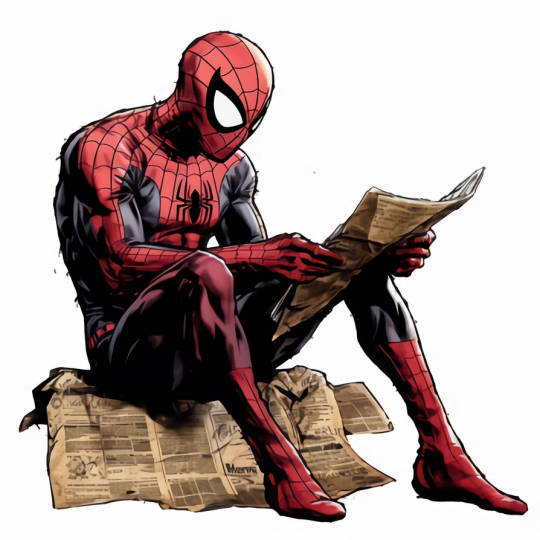
Reading Break - Worms & Spiders
Featured Art:
MotaArt: (above)
Rick Leonardi & Al Williamson: Spider-man 2099 #1
Mark Bagley & Art Thibert: Ultimate Spider-man #11
Patrick Olliffe: Amazing Spider-man Family #3
Welp!
It’s been longer since I last posted here than I'd hoped it would be. Unfortunately, I’ve had to prioritize work for the time being, and it’ll probably be a little while longer before I have the opportunity to post my next episode review [TNG ep. 123 will be next in line, when I do finally get to it]. In lieu of writing, I’ve been trying to be at least bit more mindful with my downtime, avoiding the various social media timewasters, and taking more time to read.
For my "serious" reading, I’ve been slowly picking away at ‘God Emperor of Dune’, which is pretty fucking trippy. Seriously, If you thought the first book was weird, then I’m here to tell you that whatever "spice" Frank Herbert was using, he upped the dose exponentially for each subsequent entry. I’ve read a lot of disparaging reviews and comments online about ‘God Emperor’ that led me to believe it might be pompous and dull, but I’ve honestly found it to be thoroughly engaging, though admittedly subject-at-times to some ignorant world views.

For my "fun" reading, my recent reviews of ‘Spider-man: TAS’ have inspired me to peruse through my old Spidey comics, which have been a real trip down memory lane (and very on-brand for this blog). The two series I’ve been bouncing between are the original ‘Ultimate Spider-man’ from the early 00’s, and ‘Spider-man 2099’ (early 90’s). I remember when each respective series was first being released, and how cutting edge each of them seemed. Overall, I’d say they hold up decently well, although clearly products of their time.
‘Spider-man 2099’ is unsurprisingly the more noticeably dated of the two, and a lot of that comes down to the now-unmistakeable 90’s aesthetic, along with the somewhat clunky ‘future slang’, which seems to predominantly consist of substituting profanity with vaguely techno-sounding-words. If you don’t know what the Shock I’m talking about you can go look it up for yourself. But It’s Rick Leonardi’s artwork where the book really stands out to me, though. I always thought he was an underappreciated artist, and deserved a proper run on ASM, but 2099 probably gave him a better opportunity to flex his talents.

I feel like a lot of people forget today (as I suppose they inevitably tend to) that Ultimate Spider-man was once THE hottest Spider book on the market, and while reboots-featuring-a-teenage-peter-parker may be a dime a dozen today, it was a breath of fresh air in the year 2000. It’s easy to see why too, Bendis and Bagley work great together, and it didn’t hurt that Marvel spared no expense on the physical presentation of the book. Simply put, each issue looks sharp, from the digitally painted cardstock covers, to the glossy pages; this was a book with high production values, featuring top tier talent. No expense was spared in making sure the artists were featured in the best possible light.

One thing I’ve can’t help but notice is the differences in attitudes and ideals between the two books. I know a lot of people like to pretend that comics were less political ‘back in the day’ but that’s never been true. I do think that politics have sometimes been easier to ignore during times of less civil unrest, but clearly the writers have always had opinions and ideals that were being expressed whether they knew it or not. For instance, Peter David’s work on 2099 seems to lean more politically left, and is notably quite critical of nationalist, corporate, and capitalist interests, depicting a world that feels (in some ways) more relevant now than it was back when the series was being released.
Comparatively, Bendis’ writing seems to play it a bit safer. He appears largely progressive in his social views, but also less willing to criticize institutions like the military or government beyond anything on a surface level. I can’t say it’s too surprising, since ‘Ultimate Spider-man’ only began it’s run shortly before the 9/11 attacks, and I can imagine that even if he were inclined to do so, Bendis would have likely received pushback from anything deemed too politically controversial. But some of his writing leads me to suspect he falls towards a more politically centrist stance, resulting in a book that, while being LOADS of fun, has perhaps less to say on certain social issues. Some people might argue it’s for the best, but I kinda like it when writers are willing to get a bit messy, as I think it makes for more interesting discourse. But then again, maybe I’ll find myself eating these words as I continue my read through.
I think that’s enough musing from me. The fact remains that each of the artists I’ve discussed in this post are far more accomplished than I will likely ever be. At any rate these criticisms are really more just meandering observations, about which I could easily change my mind later on. Hopefully I’ll have more time to focus on my proper episode reviews in the coming months.
But if you’ve made it this far, thanks for hanging out.
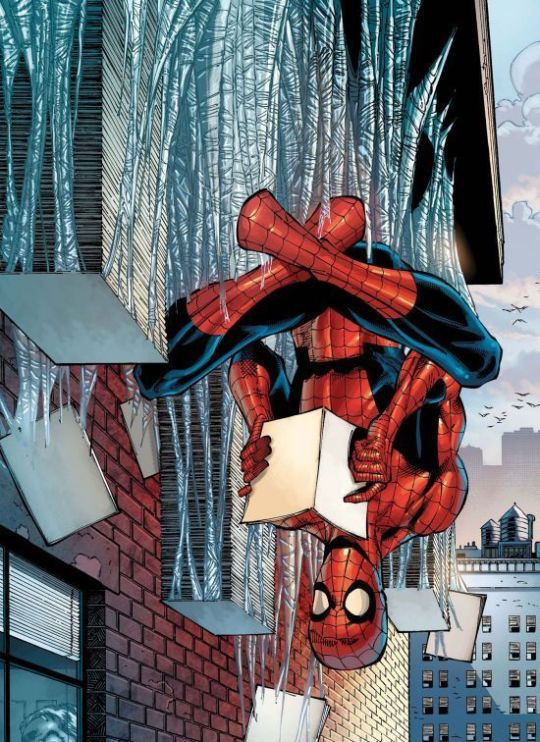
#reading break#spiderman#spiderman 2099#god emperor of dune#miguel ohara#peter parker#leto ii atreides#dune#sandworm#rick leonardi#mark bagley#MotaArt#patrick olliffe#the amazing spiderman#ultimate spiderman#comic books#dune part 2#sandworms#shai hulud#episodic nostalgia
6 notes
·
View notes
Text

Comic Book Break: The End of Venom (but not really even a little bit)
Featured artwork
Pencils: Mark Bagley
Inks: Randy Emberlin
A few posts ago I talked about how it took roughly a year after my initial introduction to Venom (through the fold-out poster from the interior of “Amazing Spider-man #365”) before I would finally get to read a full issue featuring the character. By that point I had become as well versed on the Symbiote lore as I was able to be without the aid of the internet, which basically meant I was limited to the comics my dad bought me, along with any cursory trivia he’d absorbed from glancing through back issues in the local comic shop. But issues #374 & #375 would finally reward my patience with Spider-man and Venom’s “FINAL CONFRONTATION!” And oh lordy, they did not disappoint.
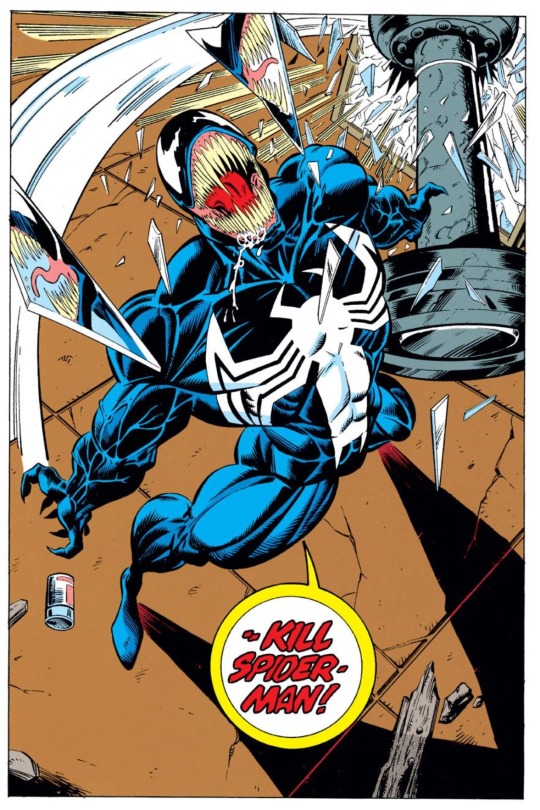
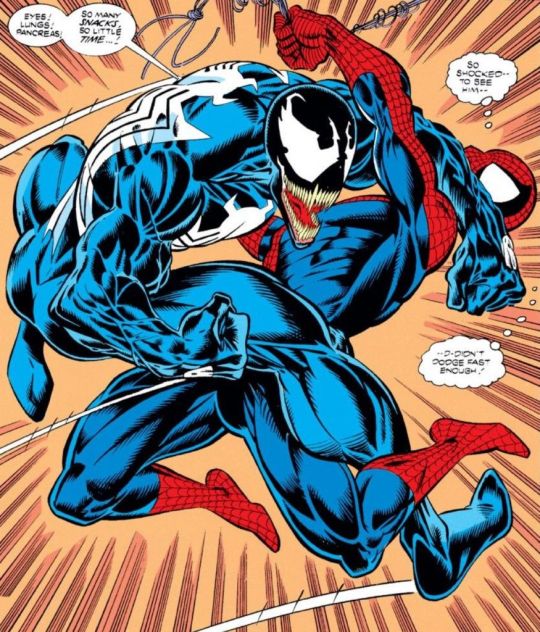
The story itself is entertaining enough, but it was Mark Bagley’s artwork that really left an impression on me. I mean no disrespect to Todd McFarlane here, but while he may have co-created the character, Bagley’s take was always the definitive version for me. Bagley’s artwork just makes him look so nightmarishly intimidating, and even with ‘the comics code’ censorship guidelines, there was no mistaking with my very-active-imagination what the character was capable of. I do remember feeling incredibly fortunate that I was even allowed to read those issues (my folks were fairly cautious about exposing me to graphic violence), especially considering this would be Venom’s last appearance ever, if the cover was anything to go by. After all, who would just lie about something like that?
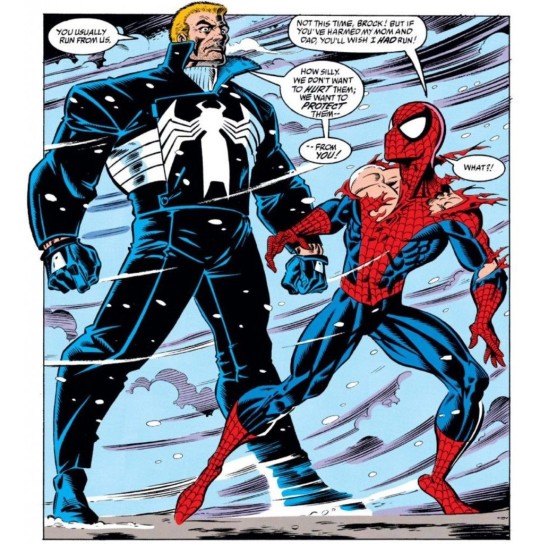

Of course, it wouldn’t actually be the last time the those two would cross paths, or even butt heads. In fact, Venom would end up returning only three issues later for the ‘maximum carnage’ saga. But these issues did (sort of) signal a change in the character that would shift his/their motivations moving into Venom’s turn as an anti-hero under the ‘Lethal Protector’ moniker, which I never found as interesting. In theory, it’s a character choice that I could get behind, but sadly Venom became a victim to weak writing and oversaturation. Of course, the irony isn’t lost on me that just as I discovered the character, his relevance in the larger cultural paradigm was about to implode. Thankfully I remained largely oblivious to all for some time, as my continued exposure to Venom would be drip fed to me through back issues or alternative media (e.g. the animated series).
Honestly though, even though these issues were obviously being sold using a cheap marketing ploy, I do think it’s a pretty solid point to ‘end’ the characters story, and least for that particular era. After all, that is the thing with comics books, you kind of have to decide for yourself when to come-and-go.
That’s also part of the fun.

#spiderman the animated series#spiderman#the amazing spiderman#black suit spider man#venom#venom suit#symbiote suit#symbiote#venom symbiote#venom origin#venom lethal protector#comic books#90s comics#mark bagley#david michelinie#randy emberlin#marvel comics#marvel 616#comic review#retrospective#sci fi#art#comic art#episodic nostalgia
6 notes
·
View notes
Text
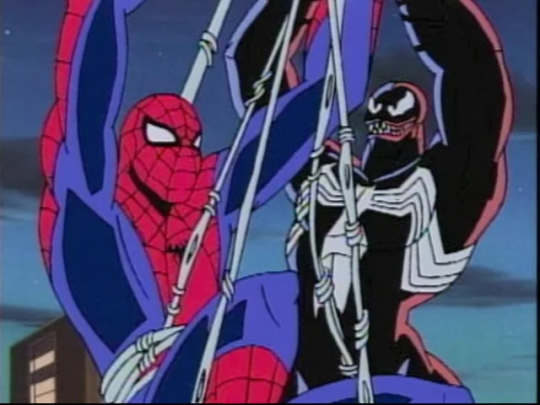
Spider-man: The Animated Series, 110 (May 13, 1995) - “The Alien Costume, Part Three”
Teleplay by: Mark Hoffmeier
Story by: John Semper & Mark Hoffmeier
Directed by: Bob Richardson
The Breakdown
Peter Parker/Spider-man is back in his classic duds, and he’s feeling pretty great about not being possessed by an evil alien goop-suit anymore. Unfortunately, Rhino and Shocker are both still feeling decidedly uncongenial about the ass-whooping they took from the ol’ web-head over the past couple episodes, and take it upon themselves to team up for some payback. However, just as it’s looking like their alliance might bear fruit, a third party enters the fray and… webs them both up? Wait, isn’t that Spidey’s schtick? Normally it would be, but there’s a new player in town who’s out for blood, and unfortunately Rhino and Shocker are just the appetizers.
That’s right, Eddie Brock has joined with the Symbiote as it’s new host, and they’re both equally PISSED at one Peter Parker. While Eddie blames Spider-man for ruining his life (even though his woes stem almost entirely from being a liar and fraud), the symbiote hates Peter for not consenting to bond with it permanently. Combined, they not only share a mutual hatred for Pete/Spidey, but Eddie also consequently inherits all of Spider-man’s powers and knowledge (including his secret identiy), courtesy of the symbiote. Having fully embraced their union, they now call themselves “Venom” since they’re like poison to Spider-man, you see, [it’s a bit melodramatic, but they’re in a mood so you just have to go with it] and now they want to destroy him.
Their first confrontation amounts to little more than a brief skirmish, with threats of more to come, but Venom does effectively dominate overall. Over the course of the episode Peter is forced to play defense as Venom comes at Peter through the various facets of his life. At one point he unmasks Peter on the rooftop of the daily Bugle in front of gawking pedestrians (Pete escapes before the cameras can zoom in on his face), another time he cock blocks Peter’s date with MJ, and most gallingly, he even knocks over the tree in Aunt May’s front yard. For those concerned readers, I feel obligated to reassure you that Peter does put the tree back into place, but Venom’s flagrant disregard for mother nature is the final push that our hero needs to take on the offensive.
In an earlier scene it’s established that a new space shuttle is about to launch from the New York area, which is unbelievably good timing, and since our hero is not one to pass up a perfect narrative opportunity he hops straight into action. The wall crawler starts by vandalizing Eddie/Venom’s apartment by posting news clippings of his recent public humiliation (from the time he was caught doing that fraud I mentioned earlier), and Venom LOSES it. But this is all going a part of Spidey’s arguably tenuous plan, who pops out of hiding to taunt him further. A chase ensues as Spider-man barely manages to keep one step ahead of Venom until they finally arrive at the rocket launch.
So what is the plan, exactly? Well, as we learned from the last episode, the symbiote is especially susceptible to loud noises, to the point where it can’t even hold it’s form if it comes across something that generates enough noise. Since a church bell did the trick last time, Spider-man figures that a shuttle rocket blast should more than do the job, and he’s not wrong. The rockets start to fire up, and the symbiote melts away from Eddie, giving Spider-man the chance he needs to collect it into a web sack, and stick it to the side of the shuttle promptly before it launches into space. With the Symbiote officially out of his hair, the web-head leaves Brock to be arrested by the authorities who don’t take kindly to trespassers, especially not ones wearing nothing but their underwear. And that takes care of that.
Oh! and Pete even gets to go on a date with MJ while he silently represses this most recent trauma, so I’d say that makes it all worth it!

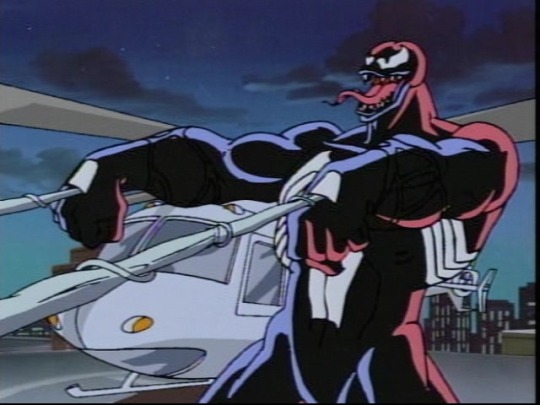
The Verdict
This was easily one of my favourite episodes as a kid, because (as I’ve discussed recently) it would have been statistically unlikely for it not to be, when taking my love of comics and impressionable age into account. Watching this episode now I can see why it would have totally rocked my world at the time, but in retrospect I’d say this is my least favourite chapter in the alien costume saga. Obviously the showdown between Venom and Spidey was always going to be the big climactic finish to this story arch, and by-and-large it successfully delivers on that front, but that’s also probably why I find the first two chapters more compelling.
In Parts 1-2 the threat to Spider-man is in losing himself TO the symbiote in a battle for what is essentially his soul, whereas here the threat is largely physical. There is still the psychological component of Venom knowing Peter’s secret, but I think we needed another episode to let that threat ruminate properly. Before there was even time for the existential dread of the situation to sink in, the two opponents are neck deep in the final fight, which ends the conflict on a fairly definitive note. Obviously, Venom does eventually return, but only once (and not for a while), and to me the appeal of the character was the dread of knowing that he/they could return at any time without warning.
That’s not to say I didn’t enjoy this episode for what it is. Once again we have another entry that’s consistent with what the show has been so far, in acting as a faithful introduction for children into Spider-man’s world. All-in-all, this episode is still more good than bad, which is a great deal more that I could say for the any of Venom’s depictions on the big screen.
3 stars (out of 5)

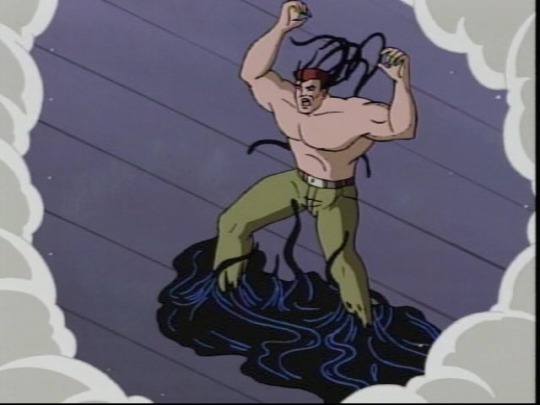
Additional Observations
Upon meeting Brock-as-Venom for the first time, Spider-man wonders how Eddie got the symbiote. Gee I dunno, Pete. maybe it happened around the same time you left an incredibly dangerous alien life form to slither away without checking first to make sure it was dead, in VERY SAME BUILDING that you left Eddie hanging by a web, where (I feel the need to reiterate) he would have surely perished when your webbing inevitably dissolved if the symbiote hadn’t intervened. But I guess we’ll never really know for sure, PETE.
There’s an unintentionally-amusing sequence where Venom gets knocked off a train while chasing Spider-man. In order to catch up with his intended prey, Venom hijacks a semi-truck (which are famous for their speed an maneuverability) to continue his pursuit. The way it’s set up I was fully expecting Venom to use it towards derailing the train, which would have been pretty rad, but instead he just politely pulls up to an over pass and hops back on the train as it passes by. It’s just so quaintly anti-climactic, and while I can’t find anything to support this, I feel like original plan probably involved something more epic or catastrophic that was cut during production. It would be perfectly in line for this show to change something like that due to censorship or budget constraints, but we’ll probably never know for sure.
Overall, Venom’s design on this show is pretty iconic, but (as many others before me have pointed out) I do his Venom’s lips a little… off-putting? Or maybe just, “not quite right”. I always preferred the more toothy/skeletal look from the comics, which looks more ghoulish and terrifying, and just suits the character a bit better, in my opinion. That being said, I’m sure this version is a better kisser, if demonic steroid junkies what gets you hot and bothered.
Venom Lore: This episode establishes that the symbiote has existed since the dawn of time, just traversing the universe and seeing the sights (including countless other alien civilizations). In the comics, the symbiote’s origins were kept a mystery for quite some time before eventually revealing that it belonged to an invasive species that travel from one planet to the next, bonding-with-and-consuming the indigenous lifeforms until they run out of compatible hosts/victims. Personally I’ve always found the second option to be conceptually more horrifying, but I’ve never seen it played out in a way that I found even remotely interesting. As much as I’m intrigued by the lore itself, I kind of prefer the idea that the symbiote is possibly the last of its kind (at least until it spawns Carnage), as it maintains some mystery. With that said, this version is less complicated, and probably serves this show’s purposes better.
On a Non-Venom related note: This episode technically marks the first team up of the show (albeit one that’s short-lived) between two fully fledged super-villains, featuring Rhino and Shocker. These occurrences would become increasingly more frequent starting with season 2, which quickly became rife with team-ups, guest appearances, and crossover episodes.

#spiderman the animated series#season 1: origins & intros#the alien costume: part three#retro review#cartoon review#spiderman tas#spiderman#venom#eddie brock#venom origin#symbiote suit#symbiote#rhino#shocker#marvel#marvel comics#marvel animation#marvel animated universe#90s shows#90s tv#90s tv shows#90s tv series#90s cartoons#saturday morning cartoons#tv review#scifi#Mark Hoffmeier#john semper#bob richardson#episodic nostalgia
5 notes
·
View notes
Text
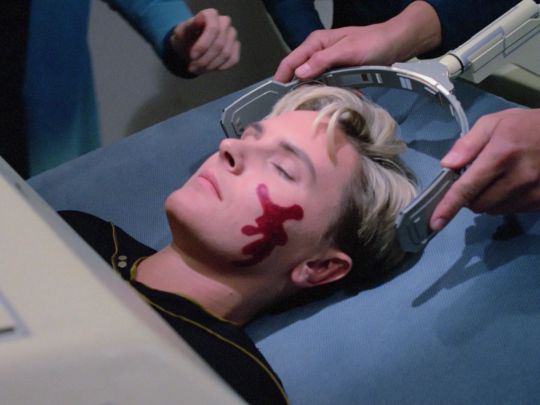
Star Trek: The Next Generation, 122 (Apr. 25, 1988) - “Skin of Evil”
Teleplay by: Joseph Stefano & Hanna Louise Shearer
Story by: Joseph Stefano
Directed by: Joseph L. Scanlan
The Breakdown
Deanna Troi’s shuttle craft suddenly loses power on it’s way back to the Enterprise and she (along with her pilot) end up crash landing on a barren planet. Fortunately, Enterprise was in communications range when the shuttle went down, so the gang zips off to help. UNfortunately the planet is controlled by a quasi-omnipotent puddle of crude oil named Armus, who has a developed penchant for inflicting pain, and emotional turmoil in others; and he senses a prime opportunity to do just that.
As it happens, one of Armus’ vaguely defined abilities is to emit a forcefield around Deanna’s shuttle to stop her from being beamed to safety. Not yet aware of what-or-who he’s engaged with, Picard sends an away team comprised of Will Riker, Tasha Yar, Dr. Crusher, & Data, where they first encounter Armus as a black puddle that keeps blocking them from reaching Troi’s shuttle (it/he slithers in front of wherever the away team attempts to go). Eventually Armus re-forms as anthropomorphic garbage bag covered in tar, and threatens to kill anyone who attempts to save Troi. Since Tasha isn’t one to take shit from a villain-of-the-week, she bravely pushes forward… and is immediately killed.
Armus allows the away team to return to their ship (although still without Troi), where Dr. Crusher tries her best to revive Tasha, but to no avail; Lt. Yar is very dead. To make matters worse, the crew is also no closer to saving Troi. Indeed, at barely 15 minutes, the bulk of the episode has yet to play out, which effectively remains in a stalemate, as Armus psychologically and physically torments the next away team (but mostly Riker).
While Armus spares no opportunity to remind everyone of how evil he is, Troi slowly manages to pump him for information back in the shuttle wreckage, with the aid of her empathic abilities. Meanwhile, Worf notices that Armus’ anti-transporter forcefield seems to weaken slightly whenever he’s busy taunting Troi. The meaning of this isn’t initially made clear, but since the episode is starting to run out of time, Picard figures it’s safe to start wrap things up, and heads down to the planet for this week’s big philosophical showdown!
Upon beaming down, Picard offers himself to Armus in exchange for his crew’s safe release, but only after he’s been allowed to have a private conversation with Troi. For reasons that aren’t entirely clear, Armus agrees to these terms, giving Picard the opportunity he needs to figure out a solution. Troi explains that the Armus is a living manifestation of all the hate and rage (akin to a “skin of evil”, if you will) from some race that somehow had those traits removed from themselves, and then presumably discarded on this planet in the form of a sentient waste byproduct. It turns out his one weakness is receiving emotional validation over being abandoned, which is remarkably convenient. Armed with that knowledge, Picard unleashes an unrelenting barrage of sympathy in the manner that only a grumpy French dude (with an English accent) could deliver; using pretentious soliloquy, and verbose sentiment.
And it works! Armus feels so seen by Picard’s observations (namely that he’s just a sad and empty shell of a tar-monster), that he lowers his guard just enough for Worf to beam the survivors and Piccard back to the Enterprise. With everyone safe and sound (except for Tasha), the crew of the enterprise leave their exasperated foe behind, along with a warning buoy for future explorers to avoid the goopy incel stranded on the desert planet.
All-in-all, a close call, but another happy endin-
...oh wait, that’s right. You see, since the crew member who died also has a star billing in the opening credits, we actually have to spend some time showing the bridge crew in a state of grief (whereas if Deanna’s barely-mentioned pilot had croaked instead, we’d be halfway through the credits already). Picard holds a funeral wherein he plays a pre-recorded holo-message of Lt. Yar herself, which I guess must be a normal thing to do in the future. Her hologram proceeds to give a VERY long, personalized thorough message for each person in attendance. Data wonders aloud if he’s missed the point of this gathering, since he keeps thinking mostly “about himself and how empty life will be without Tasha”, and Picard is like “Nah, you’re pretty much dead on.” [No pun intended]
So… another happy ending, I suppose.
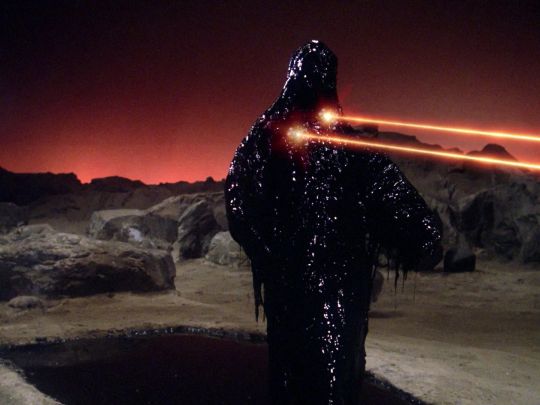

The Verdict
Honestly though, I’m with Data. ‘Empty’ is basically the only word to describe how I feel about this episode, and that’s a shame. It’s widely known that Tasha was only killed off because Denise Crosby asked to be released from her contract, but the writers could have chosen a more interesting episode to feature this story beat. The thing is, I actually appreciate that Tasha’s death wasn’t built up beforehand; I tend to fall in the school of thought that character deaths are often better served when they aren’t heavily projected or drawn out. The problem is everything else about ‘Skin of evil’ effectively amounts a nothing-episode, with very little to say, and even less to show for it.
Armus as a villain is… certainly a villain I guess, but his motivations and what drives him would leave me with more questions than answers, if only what little we did learn about him wasn’t so dull. Too much of the episode is spent on the incessant back-and-forth of Picard and Co. insisting they be allowed to save Troi, to be met with Armus regurgitating one insufferable tangent after another about how he won’t because it pleases him not to. Pretty much the only character who moves the story forward is Troi during her verbal sparring sessions with Armus, while everyone else effectively spins their wheels (I’ll give a few points to Worf though).
I don’t blame the cast for any of this though, as all my criticisms fall to the writing. In fact, most of the cast have some really solid moments whenever they’re given something to work with. Worf resisting his warrior impulses in order to take up Tasha’s mantle is well executed by Michael Dorn, as is Data’s confusion over grief (courtesy of Brent Spiner). Also, despite the fact that I didn’t find Troi’s scenes particularly compelling in-and-of-themselves, Marina Sirtis gives a strong performance, if only because she’s given something to do beyond serving as Picard’s personal lie detector.
The whole episode is such a squandered opportunity to tell a story that could have been one of this season’s (very few) highlights. Bearing in mind, this episode marks the first time in Star Trek history that a series regular dies without being brought back to life (not counting alternate realities or time travel). From the stories I’ve heard about the working conditions on the show, especially for the women cast members, I can’t say I blame Denise Crosby for wanting to leave. Still, there’s a selfish part of me that wishes she stayed until the later seasons when the show began to improve; there was just so much untapped potential for Tasha’s character.
1.5 stars (out of 5)
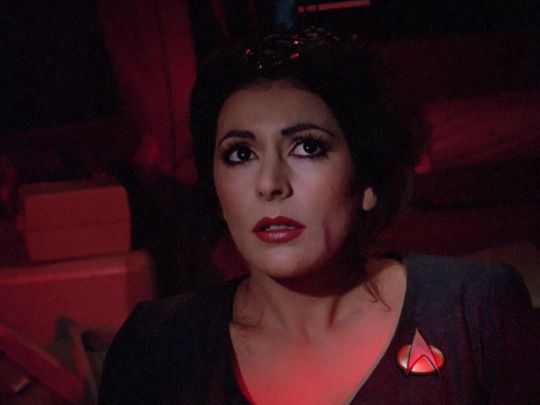

Additional Observations
So exactly how long ago had Tasha prepared that “in the event of my untimely death” holo message? She’s presumably known most of the crew for slightly less than a year, but had a full speech for each main character, as if she’d known them for considerably longer. I’m not saying she couldn’t have made close friends with the crew in that time, but that still means her recording must have been made fairly recently. Timing is everything, I guess.
Given Picard’s rigid adherence to following rules, and borderline obsessive code of honour, I would have half-expected him to stay on the planet with Armus. I wouldn’t even be all that surprised if there was an episode in season 2 where a corrupt Admiral calls out Picard’s actions from this episode, by reminding him that a “Starfleet Captain’s word is his bond”, and that he must return to Armus and be tortured for eternity, or give up his rank as captain. Of course, Picard would accept his fate because his devotion to Starfleet is absolute, but then Data would probably find a loophole in the rules somewhere, which the Admiral would have to begrudgingly accept. But seriously, you can’t tell me that premise is any less preposterous than a good chunk of season one.
Troi-SPIRACY: In an earlier post, I put forth a scenario that Troi has actually been faking her empathic abilities in order to get her lousy mom off her back, and now she’s in too deep to admit the truth. This episode would seem to refute that theory outright as evidenced by the use of her abilities on Armus, but she’s not fooling me! We mustn’t forget that Troi is a professional counsellor, who attended one of the most prestigious, and well funded academies in the galaxy. Clearly, she just used her training and experience to make some astute observations about Armus, and later attributed it to her ‘abilities’ in order to keep up the ruse. And I know what you’re thinking, “But Troi’s counsel has always seemed hiliarously antiquated in the past, almost as if it was a caricature 80’s pop psychology”; but I maintain that even that was all part of her deception. Think about it. Really THINK about it. What better way to trick everyone into believing you have superpowers than to draw attention away from them with questionable guidance? Then, having thrown everyone off the scent, all you need to do is to utilize your intellect and sharp deductive reasoning in moments of great need, and pass it off as an ‘empathic ability.’ NICE TRY Deanna! You may have everyone else fooled, but I see you for what your really are. A keenly proficient student of the human experience, and a valuable ally! Consider yourself exposed, you fraud!
Worf and Tasha were clearly flirting, right? That can’t just be me. If she hadn’t died, those two would have done the warrior tango for sure. Poor Worf. Oh well, I’m sure his future romances will all end less tragically.

#star trek the next generation#tng season 1#skin of evil#retro review#star trek review#troispiracy#tasha yar#denise crosby#armus#worf#michael dorn#lt commander data#brent spiner#deanna troi#marina sirtis#captain picard#patrick stewart#tar monster#star trek tng#star trek#sci fi#sci fi tv#character death#80s tv#80s tv series#80s tv shows#tv show review#episodic nostalgia#joseph stefano#hannah louise shearer
2 notes
·
View notes
Text

Comic Book Break: The Venom Symbiote
Featured art by
Ron Lim: Covers for Marvel Tales #266-268
Mark Bagley: Carnage/Spidey/Venom Poster
Ron Frenz: Cover for Amazing Spider-Man #252
I grew up as a Spider-man fan in the 90’s, which means I (predictably) thought Venom was the coolest villain of all time. My Dad introduced me to Spidey’s ‘modern era’ shortly after Carnage first hit the scene, which means the Symbiote villains were a hot topic. As such, my first introduction to both Venom and Carnage would be in the pages of ‘The Amazing Spider-man’ #365, and boy did that issue leave an impression.
You see up to that point my fascination with the web head was moderately new, and I remained largely ignorant to the finer points of his lore. My Dad had just begun to re-discover comic books for the first time since his childhood, and this particular issue was a extra sized anniversary edition, replete with a holographic cover, character histories, and even a handful of bonus stories that were framed around various side characters who could reminisce about Spider-man’s classic tales. It was a handy way to bring new readers up to speed, and it worked well enough on my Dad (much to my approval) for him to continue collecting until the Clone Saga ruined everything. ASM #365 also featured this absolute BANGER of a poster by Mark Bagley. Check it out!

That image was seared into my brain, and two things became abundantly clear to me 1) Those villains were unequivocally, the greatest characters in modern literature, and 2) I needed to know why. Obviously I asked my Dad who those guys were, and he proceeded to explain the basic premise of the Symbiote suit and it’s history with Spider-man. Needless to say, I became obsessed with finding an issue, ANY ISSUE, that featured Venom and/or Carnage; I wanted to know everything about these guys. The only obstacle that stood between me and my goal was my age, as I was still quite young, and I think my folks were just the tiniest bit leery of exposing me to a characters who looked and behaved like, if we’re being honest, bloodthirsty hell demons (or brain thirsty, as the case may be).
As luck would have it, my dad found a pretty fair compromise in the pages of ‘Marvel Tales’. MT was a series that featured reprints of classic-or-topical spider-man comics from days of yore, often with new cover art by a current artist. Since the introduction of Carnage was turning heads towards the Spider-man books (also around the same time the comic book speculators boom was taking off) it was a prime opportunity for Marvel to reprint the issues of ASM that introduced the original symbiote creature (written by Roger Stern). So, my dad bought me several issues (pictured up top, and immediately below) to satiate my curiosity for another year before I finally got finally see Venom himself, and in the mean time I was simply delighted to be reading the origin story as I went.

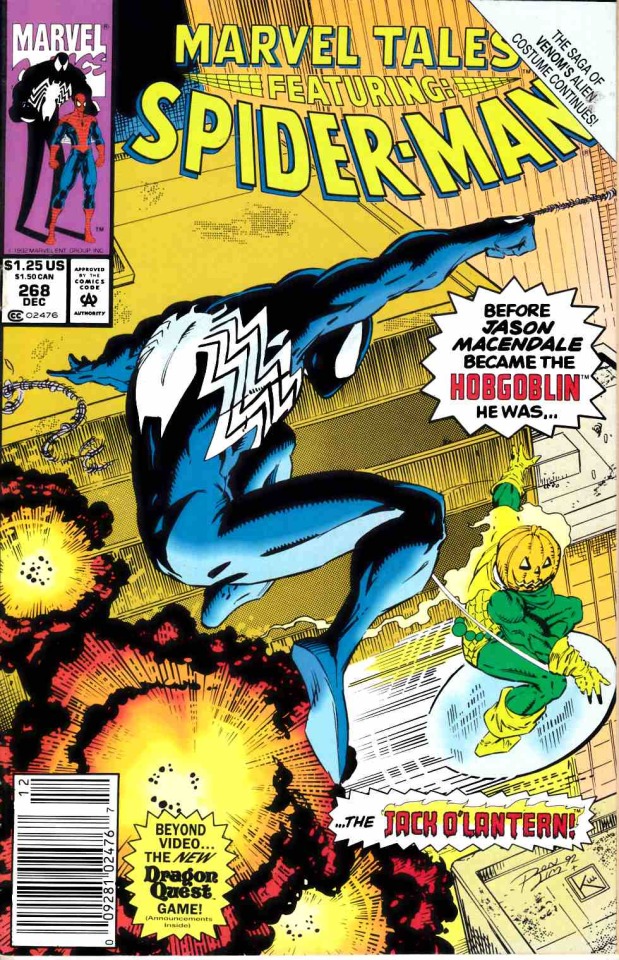
Since those days, my interest in Venom has wavered dramatically depending on the project/medium/who’s writing him, and I’ve found much of what’s been produced fairly underwhelming; but my admiration of the design for Spider-man’s black costume has remained steadfast. If I’m being (perhaps heretically) honest, I almost prefer the black costume to the original. Something about it just feels so correct for the character, and clearly I’m not the only person who felt as much. Despite some initial push-back, the black costume had garnered enough support by the end of the 8-issue symbiote saga, for it to be brought back as just a ‘regular costume, but with the symbiote aesthetic.’ From that point on, it would feature regularly for several years before Venom officially inherited the look.
And just to be clear, no I wouldn’t ever truly want to replace Spider-man’s classic look, but you gotta admit, the black suit looks mighty slick.
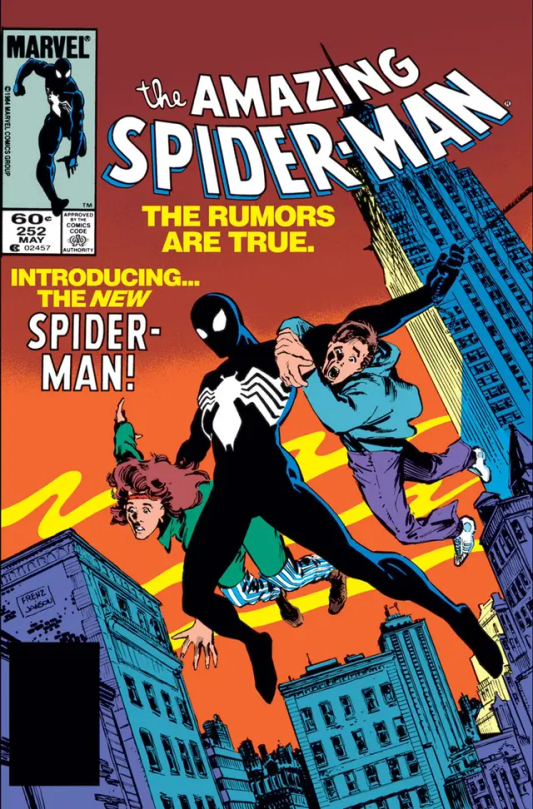
#spiderman the animated series#spiderman#black suit spider man#symbiote suit#venom symbiote#venom origin#venom#eddie brock#marvel comics#comic books#retrospective#marvel tales#the amazing spider man#carnage#maximum carnage#mark bagley#ron frenz#roger stern#ron lim#90s comics#scifi#80s comics#carnage symbiote#retro review#episodic nostalgia
5 notes
·
View notes
Text

Spider-man: The Animated Series, 109 (May 6, 1995) - “The Alien Costume, Part Two”
LAST TIME… On Spider-man:
You can read my review for part one HERE (if you haven’t already), but there was one subplot involving Eddie Brock that I didn’t really get into because my post was already running long. Basically Eddie was still sore at Spider-man over that time he got fired for being bad at his job. Consequently, he decides to sell Jonah pictures that make it look like Spider-man stole the Promethium X [*dangerous radioactive space McGuffin] from John Jameson’s space shuttle, instead of correctly laying the blame on Rhino, whom Eddie both witnessed and photographed (that bastard). As a result, Jonah has bounty placed on Spider-man’s head, and Eddie’s sittin’ pretty with his old job back.
AND NOW… The continuation
The Breakdown
Despite the constant barrage of bounty hunters trying to take him down, Spidey is doing pretty well at staying the-fuck-outta dodge thanks to his enhanced strength (courtesy of the new suit), indeed he seems virtually untouchable. Still the inconvenience of constantly being attacked is getting on the web-head’s last nerve, leading to an all out confrontation with Jonah that… doesn’t exactly go well (the wall crawler uncharacteristically loses his shit and trashes Jonah’s office), but it does lead Jonah to discovering the truth about Eddie’s deception regarding the Rhino. And so, Jonah must face humiliation by releasing yet another retraction to Brock’s latest and-most-brazen fuck-up (which of course prompts his immediate re-firing).
MEANWHILE… Wilson Fisk is still on about that whole Promethium X thing (trying to sell it to terrorists or some-such). The Problem is, Eddie Brock’s public humiliation makes him liability to Fisk since he holds the only photographic evidence of Rhino’s involvement (who I guess can be linked to Fisk through payroll statements or something?). So Fisk sends his latest super-minion, THE SHOCKER, to deal with it using murder. But of course, just as the Shocker shows up to vibrate Brock to death (Kinky), our less-friendly neighbourhood Wall Crawler arrives on the scene to save the day [also because he wanted to bully Eddie a bit himself, almost as if… SOMEthing is making him more behave more aggressively? But WHAT, I wonder?]. The ensuing fight ends up with Spidey buried in rubble just long enough for Shocker to think he’s won, and for Eddie to make his escape.
Chuffed at his supposed victory, Shocker rushes to Allistair Smythe’s hideout so he can boast about it, but of course Spider-man just follows him there. Another fight leads to Spidey stealing back the Promethium X so he can run some tests on it back at his place. Of course this naturally escalates things even further, and Allistair sets another trap with the Shocker using John Jameson as bait (kidnapped straight out of the hospital, no less. Poor guy is having a rough time). The deal is simple, Spider-man and Jonah are to meet Allistair at an old church building, where John will be returned to his father in exchange for the Promethium X.
Spider-man may be a little more violent than usual, but he’s still Spider-man, so he willingly hands over the Promethium in exchange for John, which is when Shocker shows up to spring the trap. While Allistair makes good his escape (as well as the Jamesons), Spidey and his foe have at it, and it does NOT go well for Shocker.
Like, Spider-man is UNHINGED you guys; it’s truly some meme worthy stuff.
Eventually Shocker [SHOOOOOCKKKEEEEEERRR!!!!!] gets chased to the top of the building where the belltower is located (oh yeah there’s a bell tower. Now you know), and proceeds to get the living tar beat out of him [YOOUU CAN’T ESCAPE MEEEEEE!!!]. But Just as Spider-man is about to drop the ol’ Shockster to his untimely demise [I’LL CHASE YOU TO THE ENDS OF THE EEEAARTH!!!], he remembers that Uncle Ben used to have a whole speech about Responsibility (I won’t get into it here, but it involves great power) and resolves not to klll his hapless foe. Except… the suit has other ideas and autonomously produces a tentacle to force the issue by shoving Shocker off the tower against our hero’s wishes. Thankfully, the suit still respects Spider-man’s impulse to shoot a life-saving web line, thus sparing Shocker from death-by-impact.
Having finally accepted that the suit is responsible for his new bloodthirsty attitude, Spider-man attempts to remove it, only then realizing that IT has other plans (even though Doc Conners totally warned him about this in an earlier scene). While thrashing around in a fruitless attempt to take his ‘costume’ off, the massive tower-bell starts ringing at such a volume as to drive the suit utterly BANANAS. It’s at this point that Spider-man figures out that sound is the suit’s weakness, after correlating this incident with a bounty hunter’s sonic weapon from earlier. Considering he has no other viable options, Spidey pretty much just hangs out nearby the ringing bell until the suit gives up and separates from him. From there it eventually succumbs into a puddle and slithers off into a crack, NEVER TO BE HEARD FROM AGAIN.
[Oh and I don’t know if it’s worth mentioning, but Eddie Brock followed Jonah to the church, where he tried his level best to kill Spider-man while was distracted with the Shocker. Of course he failed even more miserably than he did at his job, and Spider-man easily wrapped him up into a web cocoon, and strung him up inside the tower chamber beneath the bell.]
Anyways, with the alien symbiote out of the way Spider-man completely forgets to check in on Eddie who is still literally hanging out in the church tower. At the same time, it turns out the alien symbiote is still very much alive after all (which Spider-man probably should have double checked) and in need of a new host. Since Brock is available for a rebound (not to mention unable resist), the Symbiote helps itself. Eddie quickly goes from being terrified, to WAY TOO into it, and while we don’t yet see the end result of this new unholy alliance, it seems unlikely that it’ll be good.
I bet they're gonna be Venom now though. I just have an instinct about these things.
TO BE CONTINUED!


The Verdict
Man these episodes are fun. On the one hand, this show takes a fairly complicated piece of Spider-man’s lore, and streamlines it nicely for children’s television. On the other hand, it’s still AN OBSCENELY convoluted 20 minutes of unrestrained structured chaos. I’ve talked about this before in my other posts, but watching this show as an adult is leaves me both constantly impressed and confounded at the same time. Every choice the characters make are so hilariously unhinged, and yet somehow it all works perfectly within the context of what the show is trying to be.
One element that continues to work especially well, is Spider-man’s transition towards insanity as a consequence of wearing the suit. The original comics really didn’t lean into this idea as comprehensively back when the symbiote was introduced, mainly because the writers were still figuring it out as they went, and Venom himself was still some years away from even being conceptualized. But It’s telling that virtually every version of the character since this specific adaptation has incorporated the symbiote’s tendency to alter, dominate, and/or consume the host. It’s a story telling choice that makes sense, and one that this series deserves credit for bringing to the mainstream.
I also feel compelled to give Christopher Daniel Barnes a shout-out for this episode. Spider-man losing his shit over Shocker is (unintentionally) so funny to me. Shocker has always been a C-list villain at most, and up against the Symbiote-Spider-man he amounts to little more than a mild inconvenience, so the idea that Spider-man JUST HATES this guy to the point of flying into a murderous rage, cracks me up (even though I realize the suit is responsible). At the same time, Barnes really commits to the role here and, hilarious or otherwise, Spider-man is believably psychotic. Gotta love it.
3.5 stars (out of 5)

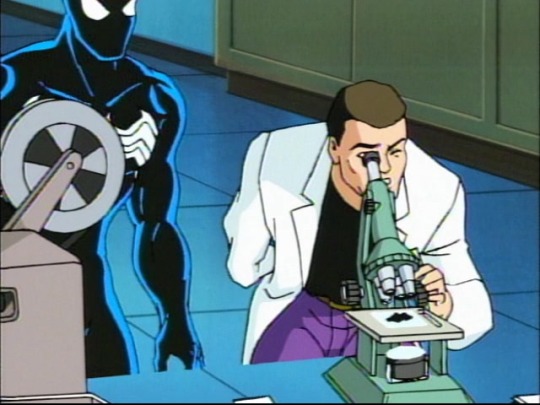
Additional Observations
There’s a scene where Spider-Man pays Dr. Curt Conners (aka the Lizard) a visit to help him figure out the mystery surrounding his fancy new extra-terrestrial duds. In order to run his tests Conners tries to take a sample of the organism, only for it to retreat from his grasp when he reaches out with a pair of scissors. Spider-man helps out by stretching out (pictured above) some of the suit with one hand so the Doc can cut it, which does work, but that still leaves the freshly cut piece of alien ‘material’ loose INSIDE Spider-man’s palm, which is also notably enclosed within the symbiote. As a kid it always bothered me that the symbiote wouldn’t have just reabsorbed the freshly cut piece back into itself before Peter could hand it over to Conners. Thankfully I’m a well adjusted adult now, so I’ve moved on from such petty concerns. Haha. Ha. …ha.
The Promethium x subplot is officially resolved in this chapter, and it’s obvious the writers barely cared about that thread more than I did. It turns out the substance has a short half life, before becoming inert, thus foiling the Kingpin’s plans and leaving Part 3 with more time to focus on Venom.
Spider-man’s personal microscope and PC must be incredibly advanced! Within seconds he’s able to determine the Promethium X’s density, structure, and molecular weight, all with sharp colour-coded images rendered directly to his computer in real time! Remarkable!
Responsibility Count – 2: Uncle Ben’s famous line returns! I’m actually surprised that it’s been used as infrequently as it has been up to this point. In my memory, future seasons would start to abuse the “power and responsibility” spiel with increasing regularity. I suppose we’ll find out as we go.
Spider-man really needs to keep better tabs on his enemies after defeating them. Last episode he just leaves Rhino unrestrained in a military facility that carries sensitive technologies, and in this episode both Shocker AND Brock are just webbed up left behind. A few episodes back (in the Mysterio episode) it’s established that Spider-man’s webbing eventually dissolves, which means Eddie probably would have fallen to his death if the Symbiote hadn’t found him. Oh well, I guess it all worked out. Besides, what are the odds of something crazy happening like all three characters returning in the very next episode? Amright!?
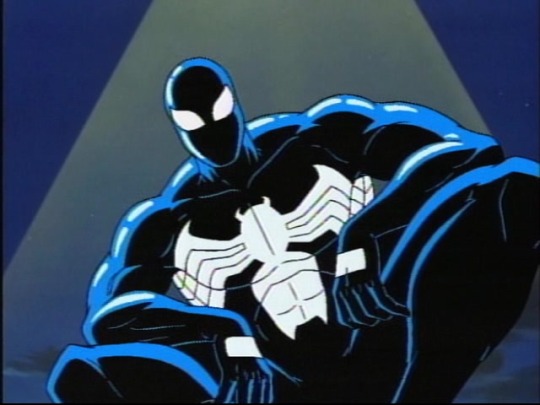
#spiderman the animated series#season 1: origins & intros#the alien costume: part 2#retro review#cartoon review#responsibility count#spiderman#spiderman tas#symbiote#symbiote suit#venom origin#venom#eddie brock#shocker#black suit#comic books#marvel animation#marvel#marvel comics#the kingpin#wilson fisk#kingpin#90s tv#90s tv series#90s tv shows#star trek the next generation#tv review#episodic nostalgia
4 notes
·
View notes
Text
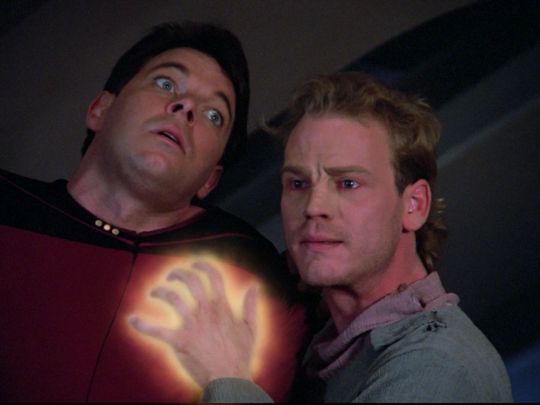
Star Trek: The Next Generation, 121 (Apr. 18, 1988) - “Symbiosis”
Teleplay by: Robert Lewin, Richard Manning & Hans Beimler
Story by: Robert Lewin
Directed by: Win Phelps
The Breakdown
The Enterprise gang are studying a star that’s undergoing some anomalous activity, which incidentally results in technical glitches across the ship’s systems. As the crew conducts their scans, the Enterprise receives a distress signal from a small freighter that’s about to get pulled into the haywire star. Picard & Co. are all about that rescuing lifestyle, but every attempt to that end gets thwarted by the star’s interference. Thankfully, Tasha is able to whip up a solution using transporter-techno-babble, but the intended guests send over their cargo (instead of themselves) on the first beam- out attempt. Consequently, by the time Tasha can lock onto the actual crew she only has time to save four survivors (out of six); curiously, they don’t seem to care all that much about their fallen comrades, instead hyper-fixating on the whereabouts of their cargo. And BOY do they seem tense about it.
So what in the gosh darn heck (excuse my language) is actually going on with these folks and their zany priorities?
We quickly find out the four survivors are representatives of two neighbouring species the Ornarans (represented by T’Jon and his buddy Romas), and the Brekkians (Sobi, and his lady-friend Langor). It’s explained that the Ornarans have been suffering for generations from a plague that is incurable. The only treatment must be administered every few days, and can only be grown on the Brekkian home world. Since the Brekkian’s have the market effectively cornered, they can-and-do charge an exorbitant fee. Sadly, the payment was destroyed along with the freighter, which brings us to our conflict-of-the-week. On the one hand, Sobi and Langor insist that the medicine is still theirs, since the destroyed Freighter belonged to the Ornarans (meaning technically the money never formally changed hands). Conversely, T’Jon and Romas remain adamant that the situation is not their fault, and (more to the point) that failure to deliver the medicine to their people would be catastrophic. To make matters worse, the destroyed freighter was one of only three Ornaran ships, with the remaining two being just as susceptible to the unpredictable solar flares of their sun.
Hoping to help resolve the situation, Picard begins with two prudent steps. 1)He offers some replacement parts to upgrade the Ornarans engines, which the Brekkians would be unable to assist with even if they were willing, as they’ve never bothered to create any ships of their own (exploitation via Big Pharma is their one-and-ONLY industry, you see). 2) Picard has Dr. Crusher perform a medical inspection on the Ornarans to make sure they haven’t spread this plague to the rest o the crew.
Curiously, Crusher is unable to find any evidence of a pathogen, or even a discernable root cause for the men’s symptoms. At the same time, Picard’s attempt to reason with the Brekkians is almost equally fruitless, except for their concession to offer two treatments for T’Jon and Romas until the matter can be resolved. This gives Crusher the insight she needs to deduce that the Ornarans aren’t suffering from a plague at all, but rather an addiction. It turns out the medicine actually did successfully cure the Ornarans several generations back, but it’s also highly addictive and since the withdrawal symptoms feel unbearable, the Brekkians continued the deception in order to keep making a steep profit. So naturally Picard will do the right thing, and inform the Ornarans of the truth. Right?
…RIGHT?
Wrong!
You see the prime directive clearly states that interfering with developing/pre warp civilizations (which I guess includes the Ornarans) is strictly forbidden. Even sharing medical research that could help the Ornarans kick their drug habit would be morally incomprehensible [on an unrelated note, I just need to take a moment to roll my eyes… annnnddd …okay I’m good] because it would because "something something cultural contamination” or whatever. And so it is with a heavy-but-otherwise-morally-justified-heart that Picard must step aside and allow the Brekkian oppressors to carry on with their oppressing unopposed.
BUT WAIT! Picard has one more sneaky ace up his self-righteous sleeve. Since he can’t won’t help the Ornarans, that means he ALSO can’t give them the engine parts for their remaining two ships. Since that means their engines will remain susceptible to the sun’s destructive influence, the Ornarans will be unable to pick up the future shipments. Once the psychologically devastating, and excruciatingly painful experience of withdrawal subsides (along with the near-certainty of economic collapse and a staggering death toll that will surely persist well into the foreseeable future) the Ornarans will eventually be able to kick their addiction and be freed from the Brekkian bond of corporate greed! YAY!
Moral of the story: obeying the letter of an ostensibly well-intentioned law should unequivocally be prioritized over compassionate care, because that’s the only surefire way to achieve a utopia.
Good thing that isn’t a deeply unsettling ideology!

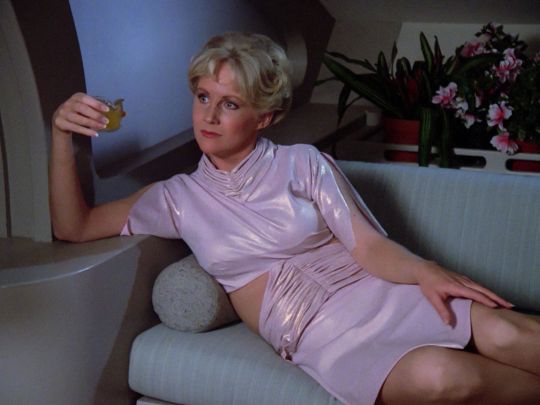
The Verdict
I’ve often taken issue with the Prime Directive as it stands within Star Trek canon. In principle I can get behind the idea that the Federation has no business interfering with other civilizations and their way of life, and I can even see the merit in waiting for an alien species to become space faring (or at least capable of long-distance interstellar communication) before mucking around in their development. My problem is with the idea that there should be any law that’s incapable of making exception for mitigating circumstances when taking into consideration the humanity (for lack of a better word) of a given situation.
After Picard sends the Ornarans and Brekkians off to their respective fates, Crusher challenges Picard’s decision not to provide aid. Picard offers the following:
Picard: Beverly, the prime directive is not just a set of rules; it is a philosophy, and a very correct one. History has proved again and again, that whenever mankind has interfered with a less developed civilization, no matter how well intentioned that interference may be, the results are invariably disastrous.
The thing is, this is only “invariably true” because of the self-imposed internal logic used within the show. The core belief here seems to be that interference can ONLY be negative, which smacks of a colonial/settler bias. Sure, whenever the USA and other western nations invade/interfere-with/overthrow politically corrupt nations like (for instance) Iraq or Afghanistan, it tends to go horribly wrong, but it would also be disingenuous to suggest that the US and their allies had truly-noble intentions, or even cared about the general (and largely innocent) displaced citizenry. If Crusher had only advocated for offering weapons and ships to the Ornarans so they could invade Brekka, I would understand Picard’s refusal to provide aid. I could even understand an argument against supplying unsupervised medical treatments, like Crusher’s alternative rehab drug, since certain pharmaceutical methods could conceivably be reverse engineered into some kind of bioweapon. But to deny the Ornarans access to the innate truth of their imposed addiction is unconscionable, even if it does lead to a heightened conflict with the Brekkians.
Speaking of faulty internal logic, Picard’s plan is entirely dependant on the contrivance of the Brekkian’s not having any ships of their own. There’s a scene wherein Data explains that, back in the day, the Ornarans were the more technologically advanced people until the plague shifted their focus towards being full time junkies. Meanwhile the Brekkians, who used to be the underdogs pre-plague, have since created a paradise for themselves on backs of the Ornarans. It's suggested that the Brekkians were simply too short sighted to bother advancing any of their own technology (or even just stealing the Ornarans) for their own advantage in the meantime. In any comparable real-world scenario, the oppressing class would almost certainly have other means at their disposal to continue their exploitative regime, which would likely continue unchallenged for quite some time.
I also can’t help but think that Picard is already playing fast-and-loose with the Prime Directive here to begin with. Like, what exactly are the rules anyway? In later seasons/spin-off series the Prime Directive is more-or-less defined as a policy of zero-interference for pre-warp civlizations, which seems to be the case here. But wouldn’t that make the initial rescue attempt of the freighter a violation in itself? You’re telling me that Picard would be forbidden from saving a pre-warp person from a housefire on the Ornaran home world, but it’s fine to save them when they’re on a space-ship even though it’s not warp-capable? Even if you make an exception for the writers not having figured out the rules yet, it would seem Picard is still breaking the internal rules of this particular episode.
But what I find most damning of all is Picard’s unwavering dedication to the Prime Directive, especially since the writers hardly leave room for the allowance that Picard could be wrong. Remember the opening line to Picard’s little morality speech above?
“The prime directive is not just a set of rules; it is a philosophy, and a very correct one.”
"And a Very CORRECT one." He said, a little too self-assured.
There is no philosophy that should be exempt from revaluation and criticism. To deny the possibility that one’s ideals could be very at least partly misguided or flawed is a very slippery slope to fanaticism.
After Picard’s proselytizing, Crusher and Picard finish their dialogue with the following:
Crusher: It’s hard to be philosophical when faced with suffering.
Picard: Believe me Beverly, there was only one decision.
Crusher: I Just hope it was the right one
Picard: And we may never know.
That’s right Picard. You may indeed never know. And that should weigh more heavily on you.
1 star (out of 5)


Additional Observations
Picard IS and Asshole: I’d never watched ‘Symbiosis’ before now, so I hadn’t initially made the connection that ‘Lower Decks’ actually did a follow-up episode. [ep 309 – “Trusted Sources” in case you’re wondering] If you haven’t watched that series (which I would highly recommend) It turns out the Ornarans did indeed suffer horribly for a little over a decade before things get better, although at least they do turn it around. We also find out the Brekkian home world would ultimately fall victim a Breen invasion that forces the survivors into hiding. I guess one-outta-two (horrifically achieved) happy ending’s is better than none?
At one point Wesley gets judgemental about the Ornarans drug addiction because he’s too privileged to understand how anyone could be less privileged than him. Tasha offers a speech about how beating a drug addiction is easier said than done, but even that just largely devolves into the standard ‘just say no to drugs’ rhetoric. The sentiment would have been common enough in the late 80’s, but needless to say it’s aged poorly.
Unintentional hilarity: It’s established that the Ornarans and Brekkians possess the ability to emit an electrical charge from their hands, which can be used as a weapon. I didn’t really talk about it before because it never has much of an impact on the story, but there’s a scene where T’Jon threatens to zap Riker dead unless Picard caters to their demands. Picard simply calls his bluff and nothing else comes of it, but Riker’s face while he’s being “zapped frozen” cracks me up.

#star trek the next generation#tng season 1#symbiosis#star trek review#retro review#star trek tng#star trek#scifi#tv show review#80s tv series#80s tv shows#80s tv#retro tv#tv shows#tv review#sci fi tv#big pharma#drug epidemic#lower decks#beverly crusher#tasha yar#wesley crusher#prime directive#robert lewin#richard manning#hans beimler#win phelps#episodic nostalgia
6 notes
·
View notes
Text

Spider-man: The Animated Series, 108 (Apr. 29, 1995) - “The Alien Costume, Part One”
The Breakdown
It’s the story of the century! Beloved Astronaut John Jameson (nice-guy-son of major-dickweed J. Jonah Jameson) is undergoing an exploratory mission of some asteroid that happened to be passing by. John discovers a fancy black rock embedded in the asteroid’s surface, that seeps a black ooze after being pried loose (whaddaya wanna bet that’s going to be important later on?). Unfortunately for our boy, his actions somehow trigger a volcanic response, which is nonsense, but it gives john a reason to escape back to his shuttle with the rock and hurry the plot along, so I’m all for it.
The rock is, in fact, a newly discovered super-powerful radioactive mineral called “promethium X”, but it’s predominantly a McGuffin for Wilson Fisk (aka the Kingpin) to cause trouble over. But none of that really matters, because the main attraction was always the introduction of…. RHINO! Oh, and possibly Venom’s backstory for those of you who are into obscure niche characters. Speaking of which…
Back on the shuttle, the goo starts attacking John and his partner, JUST as they’re re-entering earth’s atmosphere (which is admittedly not ideal). Capable dude that he is, John succeeds resist the goo’s attempt to envelop him, just long enough to make an emergency crash landing on the George Washington bridge which has been completely-evacuated-and-no-one-died.
Enter Peter/Spidey, who shows up to help rescue the astronauts from the wreckage, although not without incident, because Rhino shows up to steal the promethium X for Fisk. The ensuing fight does not go well for Spider-man, but thankfully Rhino doesn’t have time get lethal, since Fisk is eager to retrieve his prize (to be fair, Rhino does seem like the sort of guy who could get easily sidetracked). Without an active opponent, Spidey has just enough time to rescue John and his partner (the goo being nowhere in sight), before getting dragged off the bridge and into the river with the teetering space shuttle. Spider-man swims to safety handily enough, but his suit is covered in a black substance that he mistakes for pollution. Gosh, I wonder if it’s the alien goo from the space shuttle?
Predictably, yes it is.
That night, the goo jumps off Pete’s spider-suit and attaches itself to him. After waking up from a freaky (but VERY metaphorically relevant) dream, Peter finds himself hanging upside down from a web (not unlike how like a spider can), and what’s more, sporting a sharp new black ‘n white spider-themed suit. An impromptu test run reveals that the suit not only looks totally fucking SICK, but also amplifies his superpowers (plus the ability to generate it’s own webbing); additionally it can also morph into any other clothing Peter wants simply by reading his thoughts. Neat! No need to consider the horrifying ramifications of THAT any further! In spite of how alarmed he almost certainly should be, Pete ultimately takes everything in stride once the initial shock wears off, quickly brandishing a newfound (and curiously aggressive) confidence.
But there isn’t any time to bask in this new development since the Rhino is still at large, and he’s doing some more crime for Fisk in regard to that whole Promethium X thing. Armed with his new black suit, Spidey sets out to confront Rhino, and this time he completely dominates a little TOO well. In fact, as the fight progresses, Spider-man begins employing tactics that could be seen as excessive. Just as our hero is about to administer a killing blow, he snaps out of his bloodlust, and leaves before doing something he can’t take back. Shortly thereafter, Spider-man reflects on how close he came to taking a life, and is left to wonder if something is… happening to him? Oh yeah, a there’s also a flash of lighting that symbolically alters Spider-man’s reflection into that of Venom, which does seem fairly ominous, but it's anyone’s guess as to how that could be relevant.
Guess we’ll have to wait for answers though, because…
TO BE CONTINUED!


The Verdict
This story arch was one of my favourites back in the day, which is in no small part due to the symbiote. In the comics the suit stuck around as a character/element for quite a while before it became Venom, and the resulting lore that stemmed from that caught my imagination as a kid. Naturally the story had to be pared down for TV, but this show does an admirable job of reworking the complex origin of the comics, into something a little less convoluted [which includes battles on alien worlds, and a whacky mix-up with the costume-fixing-device, and I’m not even making any of that up], without outright cutting the extra-terrestrial angle. Many subsequent re-telling’s have often lean towards establishing the symbiote as a man-made-bio-suit-gone-wrong, which I personally find less interesting.
Although even as the first-of-three-chapters, there are a lot of pieces being juggled here, and while it can feel a bit rushed, you’ve gotta admire how much information is being effectively conveyed in 20 minutes of children’s programming. I believe this was the show that introduced (or at least developed) the idea that the Symbiote causes the host to become aggressive, and it’s a story telling choice that adds some real urgency to Spider-man’s circumstances. This is likewise an ideal story to introduce less complex characters like Rhino, who don’t particularly need a whole episode dedicated to explaining them [more on this in the ‘additional observations’ section], leaving more room to focus on Peter.
The animation quality in this episode seems improved as well, and I’m guessing it may have been afforded a slightly higher budget. Whatever the reason, there’s some pretty strong imagery all throughout the episode, some of which even would go on to be borrowed in Sam Raimi’s ‘Spider-man 3’ (for better or for worse). At the same time, the story suffers as much as it benefits from the aforementioned-breakneck pace, and while it’s consistently entertaining, the script (as per usual on this show) tends to sprint through the emotional beats. That’s not a condemnation of the episode though, so much as an acknowledgment of what it is, well made, chaotically imaginative escapism for children.
3.5 (out of 5) stars
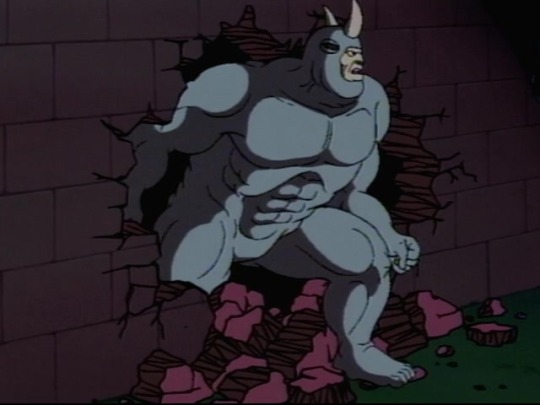
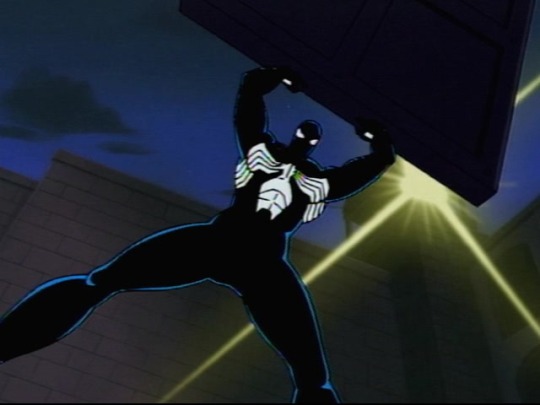
Additional Observations
the Black suit is a such a great look, and may be the only variant spider-costume (at least for Peter Parker) that comes close to matching the iconography of the original red ‘n blue. I only wish they could have extended the symbiote-saga for an entire season, but I’m sure that would have cost too much to animate, since it would have ruled out recycling character animation from previous episodes.
There’s a nice bit of foreshadowing where John is being enveloped by the Symbiote, and he screams, causing the goo to recoil. [For those who don’t know, the symbiote is famously sensitive to loud sounds] causing it to lose cohesion. I realize it’s kind of silly that any human scream would qualify as loud enough to weaken Venom, but works nicely for a kids cartoon, as a little easter egg for young audiences to notice on repeat viewings. And maybe John took some opera training back in the day. You don’t know!
Promethium X: I guess the scientific-naming-committee was feeling a bit dramatic that day. The poetic imagery must have been too much for them to pass up.
Fun fact: Issue #1 of the Amazing Spider-man features a story where Spider-man tries to help John Jameson safely land his space vessel (been a while since I’ve read it, but that’s the gist). I’m assuming that issue inspired the inclusion of John in this episode as a tactically chosen homage.
I kind of love that this show never really delves into Rhino’s deal. He’s just kinda there, like we’re simply meant to accept him at face value, and it works like a hot damn. I seem to recall ‘Spectacular Spider-man’ did a bit more with the character, and that entire series is gold, so I’d never discourage anyone’s attempt to tell a really great Rhino story, should it strike their fancy. But nine-times-out-of-ten he’s just used (and functions as) a super strong guy in a military grade anthropomorphic rhino suit, and that’s also fine; He does undeniably look like a big strong Evil-Rhino-Man, after all. I have no follow up questions, and never once felt the show missed out on an opportunity to flesh out his origin.

#spiderman the animated series#season 1: origins & intros#the alien costume: part 1#retro review#cartoon review#spiderman tas#spiderman#the alien costume#symbiote suit#venom symbiote#venom#venom origin#marvel#marvel animation#90s shows#90s tv shows#90s tv#90s cartoons#tv review#scifi#kids cartoon#episodic nostalgia
5 notes
·
View notes
Text
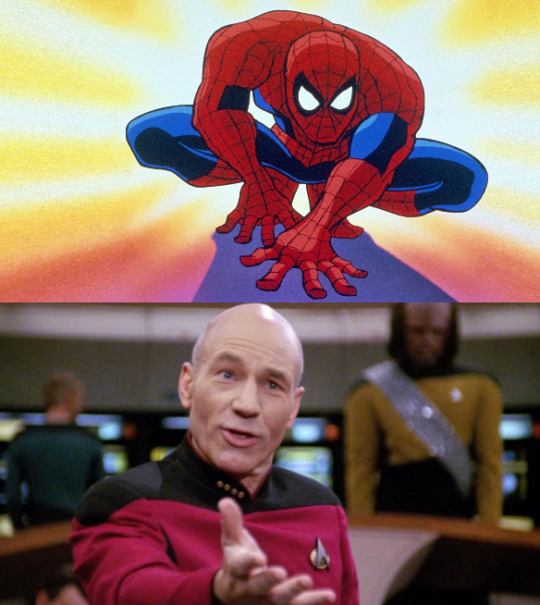
Episodic Nostalgia: 2024
Happy (belated) new years, everyone! It’s been a while since I’ve posted, due to a combination of the holidays, and taking time to catch up with some other stuff I’ve been working on. I’m hoping to post here a little more regularly over the next few months, (my baseline goal is at least one post per week, but obviously that’s all time permitting).
At any rate, I intend to continue focusing my reviews on Star Trek: TNG, and Spider-man: TAS, until I’ve completed their respective first seasons. Afterwards I may decide to temporarily shift my focus to other series (possibly Deep Space Nine, and Batman: TAS) just to shake things up, but we’ll see when I get there. In the meantime, my next review will focus on episode 108 of Spider-man, aka “The Alien Costume: Part One!”
I’d also like to thank those of you who have followed, liked, and reblogged my posts. I see you, and hope you continue to enjoy this dorky little project I’ve decided to undertake.
See you soon!
#star trek the next generation#spiderman the animated series#new year 2024#general update#season 1: origins & intros#tng season 1#star trek tng#star trek#star trek deep space nine#star trek ds9#batman tas#tv review#retro review#retro tv#sci fi tv#marvel animation#spider man#new year#tv show review#episodic nostalgia
4 notes
·
View notes
Text
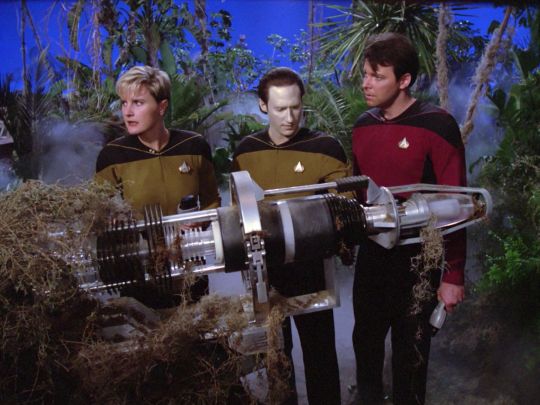
Star Trek: The Next Generation, 120 (Apr. 11, 1988) - “The Arsenal of Freedom”
Teleplay by: Richard Manning & Hans Beimler
Story by: Maurice Hurley & Robert Lewin
Directed by: Les Landau
The Breakdown
The USS Drake has gone missing after being sent to investigate a planet (Minos) whose entire population has ALSO gone missing; so naturally the Enterprise has been sent to figure out why there are so many missing people connected to one planet. On a probably-unrelated-note, it turns out the Minosians were arms dealers who sold super advanced weaponry, but I’m sure that won’t be relevant to the following 45 minutes. Anyways, the Enterprise arrives at Minos to find zero signs of life, except for a hailing frequency originating on the planet’s surface. Obviously Picard accepts the call, but it just turns out to be one of those un-skippable YouTube advertisements for a highly advanced weapons system, and Picard is like “That was weird. We should send some people to the surface to check that out.”
For what must be a first for this ENTIRE crew, Tasha makes a rational security decision in convincing Riker to keep the away team as small as possible, in the interest of general ship safety (since there is absolutely no sign of the missing Drake, which I honestly think is a MUCH bigger red flag than Picard is making it out to be). Riker agrees (taking only himself, Tasha, and Data), but gets himself caught in a statis field almost immediately, so Picard throws caution to the wind and beams himself AND Dr. Crusher down to help out… somehow. Although, credit where credit is due, Picard does have the foresight to leave Geordi in charge of the Enterprise with orders to abandon him and the away team if it means protecting the ship.
Naturally all this leads to a double-jeopardy situation. Down below, the away team keeps getting attacked by little killer drones that regenerate-and-adapt every time one gets shot down; meanwhile separate drone starts attacking the Enterprise, slowly picking away at the shields (oh, and it can cloak, making it tough to kill). Geordi finally figures out a way to outsmart his mechanical nemesis by using the displacement of Minos’ upper atmosphere to reveal the drone’s location. At the same time Picard conveniently falls into a pit that happens to contain a control panel that activates the holographic salesman (from the aforementioned automated message) who prompts him to finalize the purchase of their killer drones, in order to “end the demonstration”; thus completing what has apparently been a VERY high-stakes sales pitch.
At this point it’s been concluded that the Minosians accidentally created a killing machine that was so effective it accidentally murdered their entire species, in addition to anyone who came poking around. Since the Enterprise is now safe, and the mystery of the Drake’s disappearance is solved (in that the crew are confirmed to have met a nightmarish end), we can chalk this up to another happy ending!


The Verdict
There’s something to be said for a straightforward adventure story, and ‘arsenal of freedom’ successfully delivers on that front. I can’t say there’s enough going on here for me to classify this episode as one of “the greats,” but it makes good use what it does have.
The highlight of this episode has to be Geordi’s command of the Enterprise. It’s nice to see some genuine progression for a character that I’ve often felt gets overlooked, made all the better by the fact that I found his solution to the drone battle refreshingly plausible! Usually when Star Trek is dealing with cloaked adversaries, it gets resolved with some kind of tachyon-scanner-upgrade-techno babble. That’s all well-and-good AS LONG the writers also take care not to abuse such genre-conventions (which is another matter entirely), but I still tend to prefer solutions that adhere to the laws of physics. As for Geordi’s time in command, I also appreciate how this episode builds on his previous experiences, in throwing him a greater challenge to overcome.
The away team’s adventure definitely makes up the weaker half of the episode, but even that is at least cheesily entertaining, avoiding any glaringly cringy moments. My main criticism would be over how convenient Picard’s discovery of the control panel was, allowing him to call off the drones; but this is far from the most egregious deus ex machina on a Star Trek show, and it certainly won’t be the last.
But yeah, fun stuff.
3 stars (out of 5)

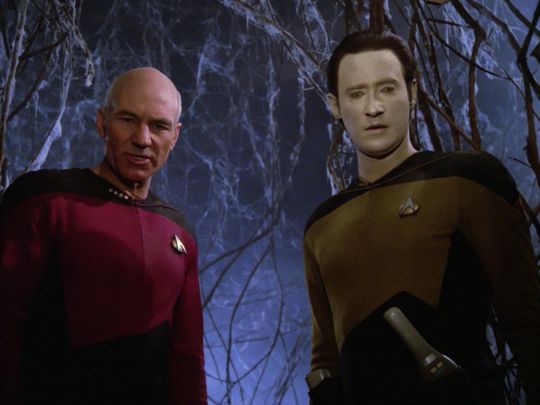
Additional Observations
I’ve gotta say, the skies of Minos are a beautiful shade of bluescreen- I mean blue.
TNG always suffered from a “women character problem”, in that the writers seldom knew what to do with them, so I was pleasantly surprised with this episode. It’s not so much that writers did anything groundbreaking with the ladies here, but this has been their best overall use of them up to this point, by my reckoning. Tasha is shown to be competent and reliable, Crusher is able to keep her wits about her after she’s injured (even getting some added backstory), and even Deanna’s council to Goerdi isn’t half bad (which is really saying something for these early episodes). The show still has a tremendous amount of work left to do in this regard, but it’s at least a tiny step in the right direction.
BATTLE BRIDGE: This is only the second time we’ve been shown the Enterprise’s saucer section separating from the rest of the ship. It’s a pretty cool feature that will be seldom used, but it’s an effective way to sell the raised stakes of a given situation, and thoughtfully applied here.
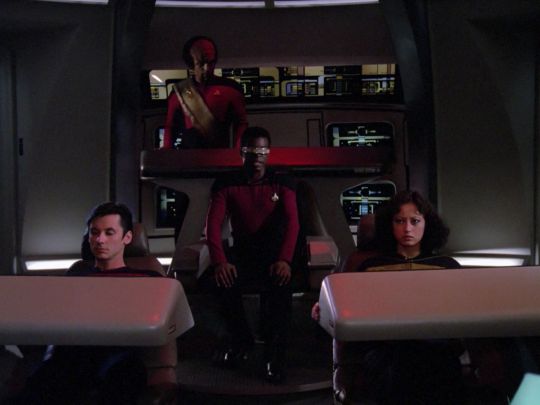
#star trek the next generation#tng season 1#the arsenal of freedom#retro review#star trek review#geordi la forge#tasha yar#battle bridge#saucer section#enterprise d#star trek tng#star trek#80s tv series#80s tv shows#80s tv#tv review#tv show review#scifi#murder drones#richard manning#hans beimler#maurice hurley#robert lewin#les landau#episodic nostalgia
11 notes
·
View notes
Text
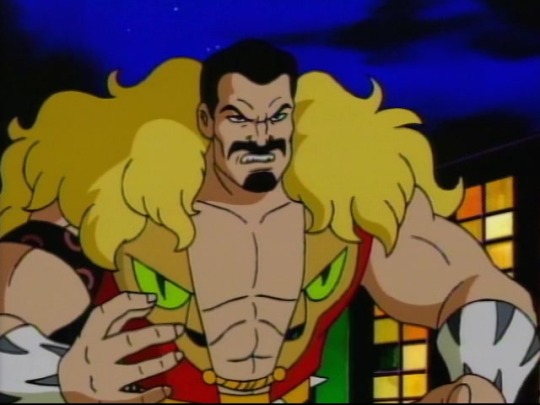
Spider-man: The Animated Series, 107 (Apr. 1, 1995) - “Kraven the Hunter”
The Breakdown
Peter Parker is up for an interview as a research assistant to one Mariah Crawford. Of course, as per his typical Parker luck, Pete arrives to find her under attack by a guy wearing a slutty little lion-themed outfit (which means the interview is understandably cancelled). So what’s the deal with this fur-clad-alpha anyway?
The Lion-dude goes by the name “Kraven the Hunter” (aka Sergei Kravinoff) and he’s an ex-big game hunter, who met Mariah when she hired him to track down an old colleague that gave himself super-feral powers with a wonder drug he discovered (So just a normal meet-cute). During their months-long journey, the two hit it off and got horny for each other, but this is a kid’s show so we’ll call it “falling in love”. Eventually Mariah and Sergei were successful in finding the good doctor, who entrusted her with the last vial of his drug in the hope that she’d develop a cure, along with a warning never to use the drug on anyone else (because living as the adonis king of a mixed species-predator-pack is too awesome for any one man to bear). Shortly thereafter Mariah is attacked by Hyenas, and barely rescued by Sergei who sustains critical injuries, leaving her with no choice but to use the super-drug to save his life. Of course it works, but eventually his new powers to turn him into a control freak with an obsession for hunting, along with a new macho nick-name (coincidentally, listening to Joe Rogan has a similar effect). Newly incentivised, Mariah to flees to New York in search of a cure.
So anyways, now Kraven is trying to romantically kidnap Mariah so that they can be together again, instead of wasting her time on a cure he doesn’t really want. Naturally, Peter intervenes as Spider-man, and takes Mariah to hide at Robbie Robertson’s apartment since he’s out of town. Predictably, Robbie arrives home earlier than expected, and Kraven kidnaps him after tracking his girlfriend’s scent there (she’d already run off, believing Robbie to Kraven). In hopes of expediting his end goal, Kraven issues a simple ultimatum to Spider-man; bring Mariah to his secret hide-out in exchange for Robbie’s life. Spider-man quickly figures out Kraven is hiding at the zoo, since it’s the only place he’d fit in (and evidently has zero night time security, or maintenance staff), and zips off to save his friend.
Meanwhile, Mariah has been making good use of her time, and manages to finalize Kraven’s antidote. Conveniently, she arrives at the zoo midway through Kraven’s battle with Spider-man, accidentally shifting the fight in our hero’s favour, although not without incident. Once again Kraven is left with critical injuries after saving her life (this time from lions, but she really needs to watch where she’s going). Apparently Mariah had the foresight to make the antidote capable of curing Kraven’s mutation AND injuries, so it all works out and the two love birds can go back to “being in love”. *wink*
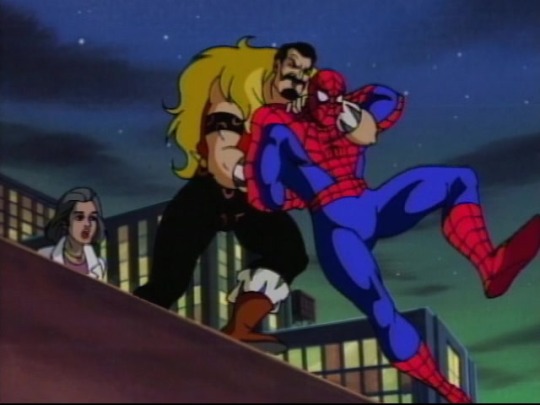
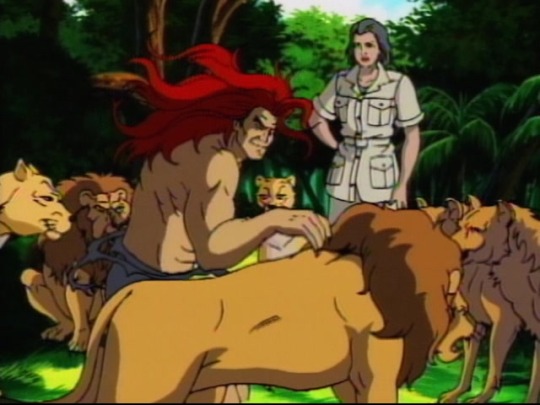
The Verdict
I’ve never been a huge Kraven stan, but the character has decidedly earned his place in Spidey’s rogue gallery. The real problem for this show is that his comic book counterpart is tied to some of Spider-man’s darker stories; even his original concept is that he just wants to hunt and kill Spider-man because no other animal offers enough of a challenge. Given the show’s harsh censorship restrictions (the writers weren’t allowed to have the characters say the words “kill” or “murder”), Kraven was inevitably up for an overhaul.
The end result is a Kraven who’s… a bit watered down compare to the original, but it works for this show, leaving him less the villain, and more a dangerous victim of circumstance. Tying his origin to a love story with Mariah at least incorporates her into his backstory from the get-go (in the comics she was introduced as Kraven’s voodoo-priestess-ally know as ‘Calypso’), even if it does completely change his motivations. The biggest aspect to this shift would come about in future episodes (which I’ll discuss more if/when I get there), suffice to say that his return would result in becoming more of an uneasy ally of Spidey’s as opposed to an adversary.
So how does the Episode stack up overall? Well, it’s about as ridiculous as the rest of this series, but I’ll be damned if it’s not a lot of fun. Why was Mariah holding interviews for an assistant position if the only reason she was in New York was to find Kraven’s cure? Considering how quickly she whipped it up at the last second, she couldn’t have been THAT far off from finding it on her own. Maybe she just works well under pressure. Also, if Kraven could track Mariah’s scent across an entire city to Robbie’s apartment (and later Peter’s to a fashion show), why not just keep following her to wherever she ended up? Oh, and what about Mariah’s colleague who invented the ‘wonder drug’ that mutated Kraven to the begin with? You know, the one who GAVE her the serum in hopes of finding a cure? Remember him? Because the writers sure didn’t seem to. Honestly though, having a friend bail on you because of their hot new boyfriend/girlfriend is probably the most realistic thing about this episode. At the end of the day these questions aren’t really of consequence, because this isn’t that kind of show. I know I sure didn’t give these matters any consideration when I was a kid (well, maybe the scent-tracking thing).
Obviously if this were intended for an older audience I’d be a lot more critical, but I genuinely enjoyed this more than the last couple episodes. ‘Kraven the Hunter’ at least succeeds at being fun, and that’s enough.
3 stars (out of 5)
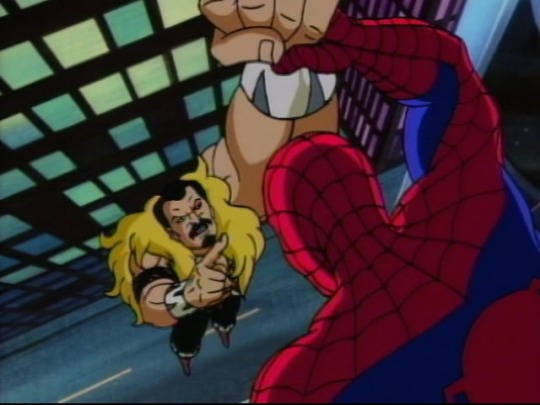
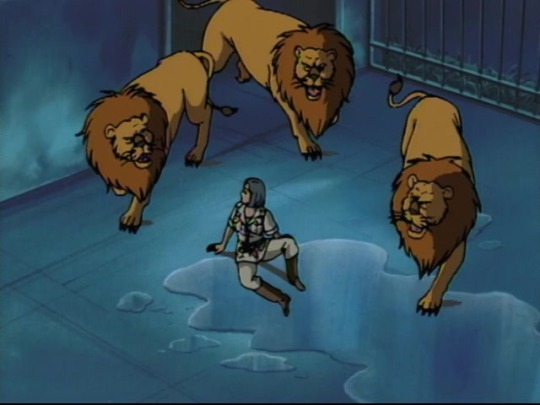
Additional Observations
This is the second research job Peter has applied for, that subsequently ended up being directly tied to a villain-of the-week (first time was the Lizard). The poor guy is bound to get a complex. Although I gotta say I’m feeling a little short changed. My Dad has been a scientist for as long as I’ve been alive, and not a single member of my family has ever come close to gaining super powers. Then again, he also refuses to experiment on any of us (don’t even get me started).
Peter attends a fashion show where MJ is performing as a runway model. She’s so excited to see him that she asks him out for dinner after the show. Unfortunately, Felicia Hardy is also present (her mom is the host), and she TOO wants to hang out with Peter afterwards. Luckily Kraven shows up looking for Spider-man so Pete has to abandon ship to go fight him, pissing off both women in the process. He really dodged a bullet there! Although, this just goes to show that Polyamory isn’t for everyone.
Kraven reveals to Robbie that as someone who was born to Russian nobility, he’s observed that the laws of the Jungle (like high society, apparently) DEMAND retribution when something of yours has been taken. Shaky logic aside, this questionable code of conduct does leave me wondering if Sergei was really that great of a guy, even before he became Kraven. Bear in mind that he only stopped big game hunting because it was outlawed, and not because of any moral convictions. I’m just saying…

#spiderman the animated series#season 1: origins & intros#kraven the hunter#scifi#retro review#cartoon review#spider man#spiderman tas#spiderman#wallcrawler#spidey#sergei kravinoff#the most dangerous game#tv show review#tv series review#tv review#old tv series#old tv show#90s tv shows#90s tv seriesr#90s tv#90s cartoons#marvel tv#marvel comics#marvel animation#episodic nostalgia
8 notes
·
View notes
Text
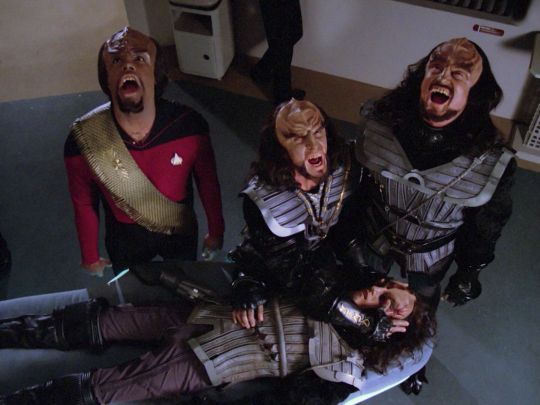
Star Trek: The Next Generation, 119 (Mar. 21, 1988) - “Heart of Glory”
Teleplay by: Maurice Hurley
Story by: Maurice Hurley, Herbert Wright & D.C. Fontana
Directed by: Rob Bowman
The Breakdown
The Federation orders Picard to investigate evidence of a battle in the dreaded Neutral Zone (a forbidden expanse that serves as the federation/Romulan border). Upon arrival, the Enterprise finds only a single Talarian Freighter stranded within the zone. Since Worf’s scans indicate possible life signs, a rescue team is sent over to retrieve any survivors before the ship explodes; but much to their surprise, the team finds three Klingons (one of whom is critically wounded). Tasha beams everyone back just as the freighter’s engine detonates, and the Klingons are brought to sickbay.
Worf accompanies Picard to meet the Klingons, arriving just as his injured kinsman croaks; and that’s when things get… a bit weird. The other two Klingons (Korris and Konmel) lean over their dead comarade, stare into his eyes, and then scream into the ceiling, rousing Worf to join their guttural display of manly-mourning (because if growling with rage in lieu of tears is a part of your culture, no one can criticize it). Meanwhile, Picard and Crusher just kind of awkwardly observe the whole thing, presumably hoping that it doesn’t escalate towards violence. Shortly thereafter we find out the screaming is meant to warn the dead that another warrior is joining them in the after life. Standard wholesome Klingon stuff.
After the boys have calmed down, Picard inquires as why the Klingons were even on a Talarian Ship, and to the nature of the battle that preceded it’s destruction. Korris explains they were initially just passengers who offered tactical assistance when the Talarians were attacked by Ferengi, but obviously that’s a lie because otherwise this would be a boring episode. The truth is, they hijacked the ship in hopes of finding a quiet little world where they could peacefully die in glorious battle. It turns out that not EVERY Klingon is happy about their alliance with the federation, with our boys Kor n’ Kon being two such folks; furthermore they want Worf to join them on the assumption that he must be going stir crazy living amongst humans. Apparently they aren’t wrong, though, as Worf does seem to at least entertain the idea of joining them. We find out Worf’s parents were killed in a Romulan attack when he was a child, leaving him for dead until he was found and rescued by the human couple who raised him. Growing up as an outsider, Worf has felt stifled by the lack of violence in his life, and doesn’t hate the idea of finally indulging those instincts.
As Worf flirts with becoming radicalized, Picard receives a transmission from a Klingon Commander named K’nera with some alarming news. Korris and Konmel are wanted criminals, and not to be trusted under any circumstances. Picard has the good sense immediately lock them in the brig, but not enough to have them properly searched for weapons, so they promptly break out and start killing people. Konmel gets shot down pretty quickly, but Koriss manages to breaks into engineering, threatening to discharge his phaser at the warp core, which would destroy the Enterprise (an action that would apparently constitute an honourable death). Worf tries to talk him down, but Koriss isn’t having any of it, so Worf shoots him dead.
After another tender ritualistic-death-growl over Korris’ body, Worf addresses commander K’nera, informing him that the fugitives were KIA, but not to feel sad because they died doing what they loved. But fuck those security guards who they murdered, AM I RIGHT? Another happy ending!


The Verdict
There’s a lot to like here, and overall I quite enjoyed this outing. After eighteen episodes of angry snarling and imposing stares, Worf finally gets to take centre stage, to largely positive effect. Even more pertinently ‘Heart of Glory’ makes good work of developing the Klingon lore, which has always been one of my favourite aspects of Star Trek as a whole. Many people will cite ‘ST: The Motion Picture’ as the introduction to “the modern Klingon”, and while that is the undeniable the origin of their current design aesthetic, I’d be inclined to credit this episode with establishing the defining charictaristics that would cultivate their larger mythology. In TOS the Klingons were a sort of bloodthirsty fascist/USSR hybrid, with some possible yellow-peril-iconography thrown in for “good” measure. By the time we got to ‘ST3: The Search for Spock’ the Klingon’s behaved more like pillage-and-plunder Vikings, in that they had a vicious appetite for glorious battle, but weren’t especially honourable. But only four years later, ‘Heart of Glory’ has a moment that is as defining as it is ridiculous. In the scene I’m referring to, Koriss and Konmel have an opportunity to take a human child hostage, but instead allow her to go free and unharmed, as they consider such an action to be devoid of honour. The scene plays out so comically cheesy that it would be easy to dismiss, but it’s a moment that highlights a major facet of the Klingon values that Star Trek still continues to emphasize today.
As for Worf, I’ve stated before that he’s a character I came to love through his tenure on DS9, but it’s nice to finally see the episode that started him on the path to becoming that character. At the end of the episode K’nera suggests that one day Worf should rejoin his people when he’s finished his commission on the Enterprise. Worf assures Picard that he’s not seriously considering it, but neither I nor the crew are fully buying it, and I appreciate them leaving that open. Both TNG and DS9 will return to this theme, as Worf struggles to fit in with other Klingons almost as much as he does with humans, and this is a strong start to that aspect of his character arch.
For all the positives, this episode still exhibits plenty of the standard season one growing pains. The melodrama is so over-the-top in places that it could almost classify as a comedy, and the characters regularly make bafflingly ill-advised choices. Also, the entire Enterprise crew is alarmingly ineffective against two Klingons. I know their species is supposed to be battle hardened and generally stronger than humans, but the Enterprise supposedly harbours Startfleet’s best-and-brightest (I shudder to think how a lesser crew would fare). Either way, Picard really needs to mandate running the crew through some drills after this dismal performance. If it wasn’t for these issues, I almost would have rated this episode higher. There’s ultimately more good than bad here, but only just barely, which puts ‘Heart of Glory’ at…
3 stars (out of 5)
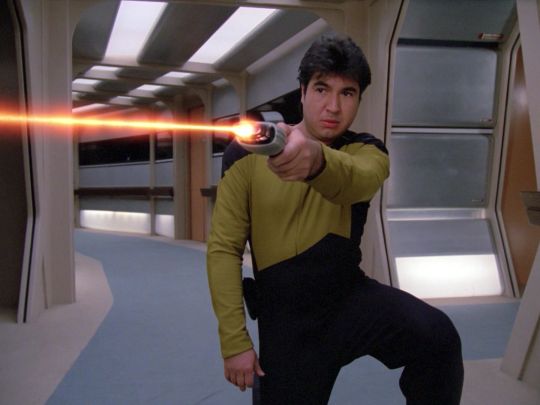

Additional Observations
Picard sends Geordie with the rescue team so they can try patching a visual from Geordi’s visor through to the viewscreen (which only has a range of a few kilometers). As far as concepts go, I have nothing against it, but it takes up a good chunk of the first act without adding anything to the actual plot. Much like the Enterprise’s separating saucer section, this segment largely amounts to a flashy gimmick, only to be utilized a couple more times in future episodes.
I will say the cinematography is admittedly more dynamic than most of these early episodes, which results in some nice shots in the engineering scene.
Korris, and Konmel are pursued by the Klingon K’t’inga cruiser under the command of K’nera. The Klingons must lose their minds whenever Sesame Street features the letter ‘K’.
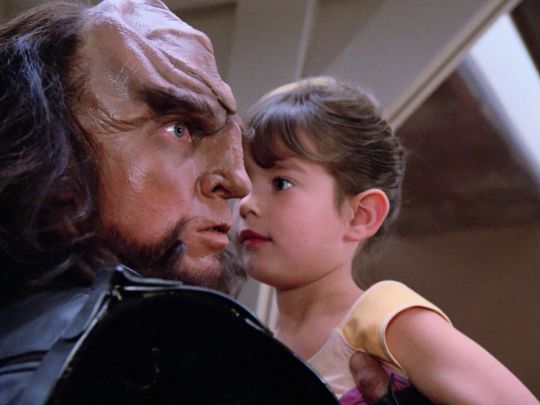
#star trek the next generation#tng season 1#heart of glory#retro review#star trek review#worf son of mogh#klingons#worf#worf rozhenko#klingon#star trek#the next generation#star trek tng#st tng#80s tv series#80s tv shows#80s tv#tv review#tv shows#old tv show#tv show review#maurice hurley#herbert wright#dc fontana#rob bowman#episodic nostalgia
2 notes
·
View notes
Text

Spider-man: The Animated Series, 106 (Mar. 11, 1995) - “The Sting of the Scorpion”
The Breakdown
Peter Parker catches an investigator (guy called Mac Gargan) tailing him, and quickly traces it back to J. Jonah Jameson. Naturally this is all part of JJ’s obsessive manhunt for Spider-man, as he figures Pete might know the webhead’s whereabouts based on all the spidey-selfies he’s sold to the Bugle; which honestly, seems like something Pete should have seen coming. Fortunately, Peter finds out what’s going on when he catches Gargan and Jonah colluding at the Bugle (say THAT ten times fast). UNfortunately, he overplays his hand by confronting Jameson as Spider-man, and issuing several thinly veiled threats of physical violence to be carried out if he ever “catches parker taking photos of him again”, all as part of a horrendously ill-conceived ploy to throw Jonah off the scent. The problem is that ol’ JJ’s intolerance for masks is tied directly his wife’s murder, killed by a masked crime lord after Jonah wouldn’t give into his demands to bury a story. Naturally, Spidey’s intimidation tactics have now freshly re-aggravated that very same haunting trauma. With a new resolve to bring Spider-man to justice, Jameson pursues the only logical course of action; call the empire state university genetics lab, so that he can create his very own masked vigilante to defeat the wall-crawler.
Jameson arranges for his buddy Professor Stillwell to use the Neogenic Recombinator (last seen transforming Curt Conners into the Lizard) on Mac Gargan, who volunteers as the guinea pig for a new experiment, since Spider-man also humiliated him. Predictably everything falls apart after that. Mac Gargan gets turned into the scorpion, goes crazy, continues mutating beyond Stillwell’s control, and decides the only way to cure himself is to blow up a nuclear reactor (The Neogenic Recombinator uses radiation, of which there is only the one type, so it all makes perfect sense when you think about it). Thankfully Spider-man subdues the Scorpion, and successfully prevents the impending atomic explosion from destroying New York. In the process, Jonah learns a valuable lesson about creating supervillains (turns out it’s a bad idea), so naturally he goes Scott free, unlike Gargan who’s transformation into a human/scorpion monstrosity will haunt him for the rest of his life (which will be spent in prison). JUSTICE!
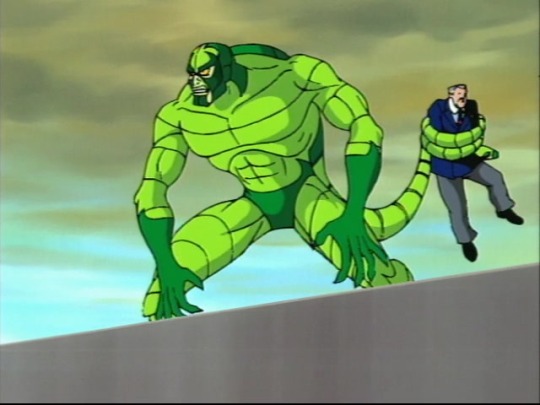

The Verdict
From the outset, this series was besought by budgetary constraints which had a notable impact on the quality of the animation, but this is one of the first episodes where it’s impossible to ignore. On top of all the usual corner-cutting tactics (recycled sequences from previous episodes etc.) the animation in this episode looks especially stilted and clunky, resulting everything from Spider-man’s acrobatics, to the Scorpion himself to appear awkward and wooden. Often, the villain-origin-episodes look a little fresher, but this one apparently drew the short straw.
I’d be more inclined to forgive the animation if the story had more to offer, but even that falls flat. It’s not like this show was ever known for it’s nuanced storytelling, but even as far as action/adventure stories go, this one is by-the-numbers and predictable. I also take issue with how Jonah is never made to take accountability for the creation of the Scorpion, as both he and Stillwell should have reasonably been arrested along with Gargan. I realize I’m being a bit pedantic over children’s cartoon, but I remember this bothering me even as a kid, and I bet even this show would have better addressed Jonah’s culpability if he hadn’t been a key character.
2 stars (out of 5)
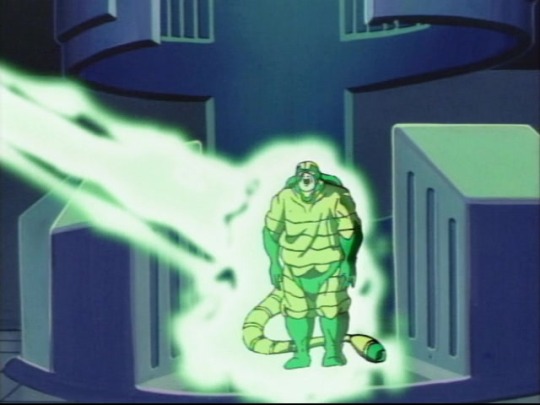
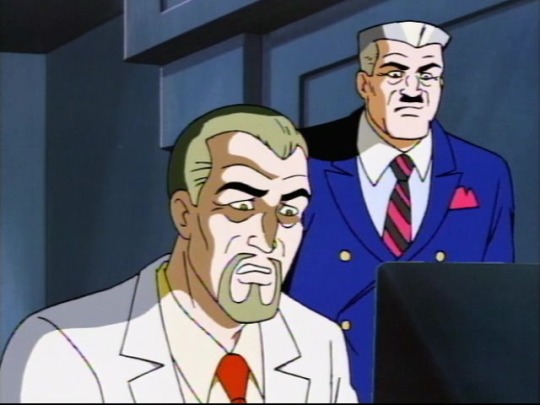
Additional Observations
We’re given a tragic backstory to J. Jonah Jameson that’s meant to explain his hatred for Spider-man, but since the character effectively never develops or changes it’s might as well be meaningless. This perfectly highlights the main issue I’ve always had with Jonah, namely that he’s perpetually stuck in loop of hating Spider-man, while constantly having his prejudices proven wrong. It’s a dynamic that grows stale quickly without any long-standing consequences, in either direction. He's never held accountable for his actions, nor does he ever accept responsibility for abusing his media platform (which he apparently takes seriously). It’s a point I’d be less inclined to raise over a kids show, especially one from the 90's, but this particular episode features the character so heavily that it’s hard to ignore.
This is the second supervillain to be created by the Neogenic Recombinator, a one-of-a-kind prototype that can apparently create super powered beings in mere moments, with wildly unpredictable results that regularly lead to violence. I gotta say, whoever’s funding this research really needs to pay closer attention, because there is ZERO chance that Stillwell’s experiments are upholding any kind of ethical standards. Although I’m sure the university has finally learned their lesson, and placed a full time security detail on the recombinator. Because I'll tell ya, If they’re not careful, that thing is liable to create an entire season’s worth of mayhem.
The episode is bookended by Pete’s love life with Felicia, which she initially balks at because she’d rather keep him as a tutor than a boyfriend. Peter ends up ditching her for a Spider-emergency, but she believes he was playing hard-to-get, and this makes her so perplexed that she ultimately agrees to a date (because men usually don’t reject her, which I suppose might be frustrating if that’s you’re kink. Ours is not to judge). The show frames this as a win for Pete who’s just happy to be given a chance with her, but looking back with an adult perspective, their whole dynamic is pretty unhealthy.
While we’re discussing Pete’s love life, I’m left to wonder if this episode was originally meant to take place earlier in the series. Felicia and Pete have already been shown in a romantic light on more than one occasion prior to this, which makes her apprehension at dating him seemingly out of character. Additionally, When Aunt May invites Peter to have lunch with her and the Watsons (including MJ), Pete seems less than thrilled about, even though he was hot for her in the very last episode. I suppose teenagers are fickle.

#spiderman the animated series#season 1: origins & intros#the sting of the scorpion#retro review#cartoon review#neogenic recombinator#spiderman tas#spiderman#marvel#marvel animation#marvel comics#marvel tv#mac gargan#tv review#90s tv#90s tv shows#90s tv series#the scorpion#scorpion#j jonah jameson#felicia hardy#superheroes#superhero#episodic nostalgia
4 notes
·
View notes
Text
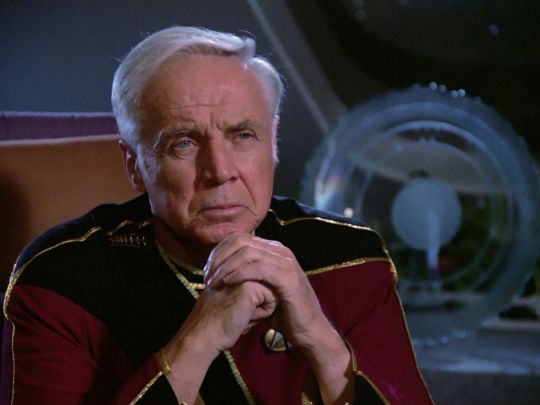
Star Trek: The Next Generation, 118 (Mar. 14, 1988) - “Coming of Age”
Written by: Sandy Fries & Hannah Louise Shearer
Directed by: Mike Vejar
The Breakdown
This is one of those two-separate-plots-that-occasionally-overlap-but-never-in-a-meaningful-way episodes. So let’s start with…
Plot #1: Wesley’s test - Wesley has an opportunity to join Starfleet academy if he can get the highest score on a test, between him and three other academy-hopefuls. The test involves standardized questions/puzzles/brain teasers, along with a series of considerably more traumatizi- er, I mean, “personalized psychological evaluations” *wink*. For example, a Zaldan (a species that look human with webbed hands) threatens physical violence toward Wesley for accidentally bumping into him, but it turns out that the Zaldan’s just hate courtesy and consideration, which means that Wesley passes this “test” by challenging an adult twice his size to a fight. In another case, Wesley is put through a simulated test (which he believes to be real at the time) to see if he’s capable of leaving someone to die in order to save another. You know, routine situations that teenagers should be made to endure in preparation for their post secondary education. Anyways, one of the other students gets a slightly higher mark, so Wesley is told he’ll have to try again the following year. C'est la vie.
Plot #2: Picard under review – Picard gets ambushed by his old friend Admiral Quinn (which is just CLASSIC Admiral behaviour, to be honest). Quinn has brought along Lieutenant Commander Remmick from the inspector General’s office (basically Starfleet internal affairs) for the purpose of investigating the inner workings of the Enterprise. Why? Well Remmick insists that something is VERY wrong with how the Enterprise is being run, and while he won’t say what he’s investigating, he goes out of his way to make sure that EVERYONE feels the heat. Nonetheless, Admiral Quinn insists that Picard isn’t to interfere in anyway, except to provide the Lt. Commander douchbag his full support.
Remmick’s investigation involves breathing down the various crew member’s necks while they go about their work, and occasionally resorting to full-on interrogations. While Riker initially seems to be the target of interest, Remmick eventually shows his hand by indicating that it is Picard who is under review. Remmick then proceeds to criticize the greatest hits of season 1, including when the Traveller sent the Enterprise to another galaxy (as per Starfleet’s orders), and that other time Picard kind-of-but-not-really defied the prime directive to save Wesley’s life (although to be fair, even I’m still mad about that one.)
Sick of Remmick’s bullshit, Picard confronts Admiral Quinn, insisting he has a right to know why he’s under investigation. It turns out that Admiral Quinn is concerned about a Conspiracy, and he’s looking for people he can trust. Apparently Remmick was simply meant to rattle the cages just to double check that Picard wasn’t hiding any evil secrets (because alerting a potential enemy that they’re being watched is a solid tactic). Satisfied that Picard is a straight shooter, Quinn offers him the head position at the academy, so that he’ll have an ally closer to home. But Picard is like “Nah, I like being a captain. But call if you need me,” and Quinn basically just shrugs and says “I had to try. Hopefully that whole conspiracy thing is just my imagination getting the better of me. LOL”
Lol indeed.


The Verdict
I’m not opposed to episodes that feature two disparate stories, in fact that layout can work especially well when one of the plots covers heavier subject matter. In this case, we have Wesley’s story, and then we have Picard’s, which I’m guessing is meant to build towards a future story arch (I’m putting my money on season’s penultimate episode ‘Conspiracy’). The problem is that neither of these narratives really amount to much.
Wesley’s story is just not that interesting to me, partly because I find the character annoying (for most of the same reasons as everyone else), but also because it doesn’t really show us anything we didn’t already know about him. He’s still a plucky kid with a good heart, who’s enthusiasm must one day be tempered by experience and wisdom. But since today is not that day, there’s really nothing to report. The only sort-of good thing to come from this episode is a bit of encouragement from Picard, who reassures Wesley that dealing with failure an important lesson-in-itself. It’s one of the less hostile interactions between the two, so I suppose we can chalk this up to some mild character development for Picard if nothing else.
Picard’s story would be slightly more compelling if the drama wasn’t so contrived. I was actually intrigued at the prospect of a Starfleet ‘anyone could be the enemy’ conspiracy, but the way it’s initially set up, resulted in my spending most of the runtime irritated at how unnecessarily hostile Remmick was during his investigation. It would have been considerably more interesting to have it start as a ‘routine investigation’ that slowly starts to reveal something more. Likewise, having Quinn insist that he NEEDS Picard to take a promotion, only to have him easily accept no as an answer is anti-climactic. Strumming up false stakes to temporarily manufacture heightened drama isn’t exactly uncharted territory for Star Trek, and this episode succinctly falls into that territory. While it wouldn’t have been as dramatic, I would have preferred Quinn simply reveal that he needed to be sure Picard was on the level, and that “someday soon I may call on you to help with this conspiracy I’m worried about”. Having Quinn emphasise the importance of getting Picard’s help, only to wave it off as a possible overreaction at the end, simply undermines the supposed importance of his request.
2 stars (out of 5)

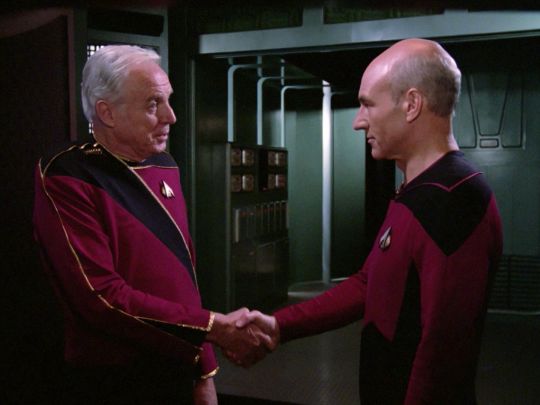
Additional Observations
Badmiral?: Admiral Quinn may not be an Evil Admiral, but he’s not exactly a very effective one either. I guess we’ll see how he holds up when he returns (which I’m assuming he does).
Has anyone talked to the Zaldan’s about maybe accommodating other species that DO practice courtesy? I can understand Starfleet/the federation bending over backwards to accommodate the customs of other cultures during a diplomatic mission, but once a species has willingly joined the federation, you’d think that they’d be equally responsible to likewise accommodate the other cultures they’ve allied themselves with.
Worf confides in Wesley that it’s difficult for him to rely on others, as it conflicts with his Klingon nature. So far Worf has amounted to little more than a growling set piece, making this one of the first times he gets any character definition to speak of. I’ve always been a big Worf fan, but my familiarity with the character is predominantly through Deep Space Nine, so I’m interested to see his early development unfold on this show.

#star trek the next generation#tng season 1#coming of age#retro review#star trek review#badmiral#star trek tng#star trek#sci fi#80s tv#80s tv series#80s tv shows#tv show review#old tv show#conspiracy#sandy fries#hannah louise shearer#mike vejar#episodic nostalgia
0 notes
Text
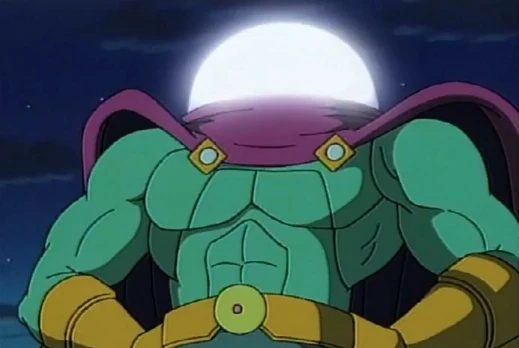
Spider-man: The Animated Series, 105 (Feb. 25, 1995) - “The Menace of Mysterio”
The Breakdown
Spider-man has taken to a life of crime, and no one is more surprised that Peter Parker! When news footage airs of Spider-man robbing a museum, Pete heads over to the scene of the crime (where Jonah is holding an anti-spidey press conference) in search of clues to clear his name. Pete’s snooping gets him caught by Detective Terri Lee, but she opts to let it go (for the time being) when some weirdo in a fishbowl and purple cape interrupts the press conference. This particular nutcase calls himself Mysterio, and assures everyone that he is the hero who will finally bring Spider-man to justice. He then disappears in a theatrical puff of smoke, before Jonah has an opportunity ask any follow up questions, but NOT before terrorizing the crowd with some frighteningly realistic illusions; finally a hero that New York can feel safe around
Spidey’s initial encounters with Mysterio do not go especially well, and he finds himself both defeated and publicly humiliated in the process; worse yet, it also results in Peter missing a date with Mary Jane. After licking his wounds, Pete visits Detective Lee as Spider-man, where she helps him uncover Mysterio’s identity by pulling up an old police file. It turns out Mysterio was once a Hollywood Special Effects technician, Named Quentin Beck, who was the best-of-the-best until he went too far and almost blew up a helicopter for some action movie. Thankfully Spider-man was on hand to save the day and expose Beck’s criminal negligence, bringing him to justice… for a little bit. Since getting out of prison, Beck has used his expertise (and apparently limitless resources) to exact his revenge by masquerade as a superhero, frame Spider-man, and then defeat him publicly.
Of course, Spider-man ultimately foils Mysterio in their obligatory climactic showdown, using his Spidey-sense to determine which of his adversary’s traps are lethal, or merely illusions. As a nice bonus to Mysterio’s defeat, Terri Lee and Spidey become allies. Oh yeah! And Mary Jane even decides to cut Pete some slack and give him another shot at taking her on a date. Another happy ending all around.

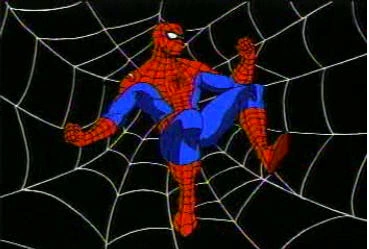
The Verdict
I must confess, I’ve never had much interest in Mysterio. That’s not to say there isn’t a time and place for the character, and some iterations are more worthy of consideration than others, but his gimmick quickly grows old. It’s always the same: Something out of the ordinary happens that makes Spider-man question his reality, until he’s forced to trust his spider-sense, revealing it was an elaborate illusion all along. Rinse. Recycle. Repeat. It’s no surprise to me that the showrunners would use the character sparingly, moving forward.
The strongest parts of this episode are those that don’t focus on Mysterio at all. The subplot (which I skipped over in my breakdown) features Peter wanting to give up on being Spidey altogether after his initial defeat. Thankfully Terri Lee conveniently makes a comment to Peter that causes him to reconsider early retirement, but it’s in this character beat that we’re finally shown Spidey’s fabled origin. It’s actually a pretty economical way to bring a young target audience up to speed on the wall-crawler’s backstory, while tying it to his current existential dilemma. World building aside, it’s the theme of power and responsibility (overstated as it has come to be) that has always endeared me to the character; If only that theme could have been introduced in a stronger episode.
In the end, I can attribute neither love nor hate toward ‘The Menace of Mysterio’, but rather an apathetic “Meh.”
2.5 stars (out of 5)


Additional Observations
I realize that supervillains being in possession of expensive toys is a trope that one sometimes has to accept; but seriously, HOW is Mysterio paying for any of this? In this episode alone he has tiny cubes capable of projecting a wide array of complex illusions, animatronic dinosaurs/pirates/zombies/spiders, and a giant hydraulic spinning wheel (the original purpose for which I couldn’t possibly hazard a guess). Having actually worked in the film industry, I am confident that even a highly paid SFX technician wouldn’t be able to afford all those gadgets without additional funding. Indeed, I’ve only worked on a handful of films that would have possessed a budget large enough to accommodate even half the technology utilized by Mr. Beck, and even those would have been rentals. I’m beginning to suspect the writers didn’t even care about the financial logistics of supervillainy.
Responsibility count: With Uncle Ben's Introduction, Peter utters the show's very first use of "with great power comes great responsibility." But don't worry if you missed it, we're gonna hear that chestnut MANY times before the series comes to an end.
Pete’s missed connection with Mary Jane was supposed to be a study-date for her requisite physics class (MJ is otherwise a student of the arts/acting), hence why she’s miffed when Pete fails to show. Thankfully it all works out, as she explains she chose to just knuckle down and do the studying herself, passing the test in the process. That’s all well-and-good, but then she drops some platitude about how arts and sciences are basically the same thing because “they’re both about trying to understand the world around us”. I appreciate that, broadly speaking, that may be philosophically pertinent, but it’s just such irrelevant point to make, considering that truth derived through artistic mediums is often considerably more subjective (particularly in a class setting). It’s also precisely the sort of comment I would have once nodded at ponderously in theatre school (especially if it was said by a cute redhead), and I don’t appreciate being called out like that.

#spiderman the animated series#season 1: origins & intros#the menace of mysterio#retro review#cartoon review#Responsibility count#Spiderman tas#mysterio#quentin beck#uncle ben#power#responsibility#power and responsibility#with great power comes great responsibility#90s tv#star trek#90s tv shows#90s tv series#80s tv series#animation#animated series#spiderman#marvel#marvel animation#marvel animated universe#marvel animated series#episodic nostalgia
2 notes
·
View notes
Text
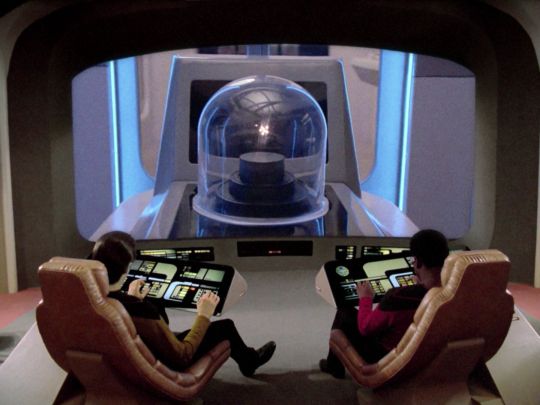
Star Trek: The Next Generation, 117 (Feb. 22, 1988) - “Home Soil”
Teleplay by: Robert Sabaroff
Story by: Karl Guers, Ralph Sanchez & Robert Sabaroff
Directed by: Corey Allen
The Breakdown
The Federation has asked Picard to check in on a terraforming outpost, since the team that was stationed there has gone radio silent. With the Enterprise’s arrival at the outpost, the project director (Kurt Mandl) reluctantly picks up to explain that nothing suspicious is going on, and that Picard is welcome to politely fuck off (I’m paraphrasing, but that’s the gist). Counsellor Troi confirms that Mandl is indeed as shifty as his unmistakably shifty behaviour would suggest; so, Picard sends Riker down to check it out. While there, Riker and his team are introduced to the other Terraformers (Arthur, Bjorn, and Luisa), who kindly provide the audience/away team with a useful exposition dump about how the terraforming process works. They impress upon Riker and co. that every planet designated for terraforming undergoes rigorous vetting to first determine that there are NO LIFEFORMS WHATSOEVER, before they begin the decades long process. Geordi starts to nerd out with Arthur about some of the unique challenges this planet has presented, but Mandl sends Arthur away to ‘go work on the drilling lasers’, because they have a tight schedule to keep. Predictably, the drilling lasers go bonkers and kill Arthur, so now we have a mystery on our hands.
Since it does KIND OF seem like Mandl had his guy killed in a cover up attempt, Picard brings the terraforming team to stay on the Enterprise while his people try to find out what caused the malfunction. During that time, Data has his own run-in with the killer-laser (which he destroys) and is able to determine that something was indeed controlling it, but it wasn’t Mandl. Further inspection of the drilled bedrock leads Geordi and Data to discover some glowing matter that exhibits strange properties, so they have it beamed up to Crusher’s lab. There, it’s determined that they’ve discovered the first known non-carbon life form, and that it’s not only attempting to communicate, but also capable of reproducing. What initially looks like a Christmas light on a petri dish, begins to grow until it eventually forms into an exotic looking plastic crystal, roughly the size of a baseball. While this is all initially very exciting for the Enterprise crew, things get a bit more concerning when the non carbon lifeform reveals that it plans to wage war on the gross ‘water bags’ that attacked it (aka humans). To make matters even more dire, the life form starts taking over the ship’s computer functions, as it grows exponentially more powerful.
So what’s going on? Well, it turns out that the terraformers did indeed notice some exotic energy deposits on their planet, but they didn’t think much of it at the time. Little did they know that their terraforming was endangering the saline water deposits beneath the planet’s crust, which apparently serve as a sort of networking system for the micro crystalline life forms living there. So why was Mandl’s team behaving so secretively? Because they’re workaholics and they don’t like distractions, and that’s… apparently the actual reason for their behaviour. With that out of the way, team-Enterprise figures out they can stop ol’ Crystal (I’m calling it crystal now) by dimming the lights, which were evidently the source of it’s power. Crystal agrees to a peaceful surrender, on the condition that no more Water-Bags return for at least 300 years (which is fair enough), and Riker has it beamed back to the planet. Mandl won’t be able to finish his project, but at least it’s led to an exciting new discovery, and all it cost was Arthur’s life. WORTH IT.
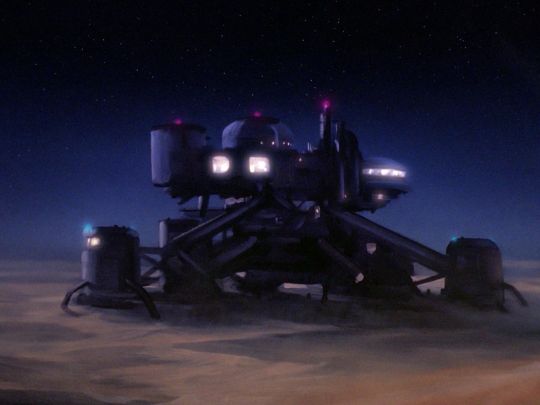

The Verdict.
Considering how many aliens look like humans with forehead prosthetics (Yes, I realize there’s an episode that addresses this), it’s kind of refreshing to see a Starfleet crew discover non-carbon life that isn’t just an abandoned supercomputer, or some other kind of artificial intelligence. Realistically, if humans ever did discover extra-terrestrial life, it seems reasonable to expect that it would be almost wholly unrecognizable to us. To that end, I found myself enjoying the story when it focussed on the mystery of a truly ‘new life’, something alien in every sense of the word.
Where the episode loses me is in the red herring that kicks off the episode, which suggests that Mandl’s team are up to no good. We spend much of first couple acts as Picard and Mandl play cat and mouse with the truth, but the answers we’re given don’t really justify the investment we put into them. Mandl WAS acting very suspicious, and Deanna supposedly could sense he was hiding something, so what exactly was he trying to hide? He didn’t murder Arthur, and apparently neither he nor his team were aware that they were harming an unidentified species. Mandl doesn’t even really give any kind of satisfactory explanation for his lack of decorum when Picard first arrived, leaving us to chalk it up to professional tunnel-vision. So, I guess he was trying to cover up… scheduling delays? I don’t buy it. I love a good red herring as much as the next guy (and trust me, the next guy won’t fucking shut up about them), but a red herring still needs an explanation that holds up to scrutiny.
It would have been a stronger choice to have Mandl (or one of his team) acting with malicious intent, leaving a conflict that would be a little more complicated, and more interesting, to resolve. Star Trek doesn’t always need to be a morality play, but that is the foundation upon which the franchise was built, and there was a decent opportunity to weigh the balance of scientific ambition with ethical restraint. As it stands, ‘Home Soil’ narratively amounts to little more than “Woops. Our bad. Sorry about that.” Perhaps that doesn’t classify the episode as an outright failure, but at it’s best this was a missed opportunity.
2.5 stars (out of 5)
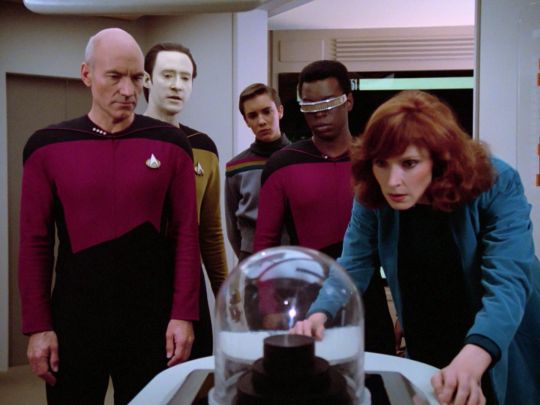

Additional Ovservations
The electronic voice given to the NCL (aka “Crystal”) sounds kind of like a slightly less annoying Dalek. Couldn’t the computer have provided it/them with something that sounds a little more dignified?
Troi-spiracy: I think it would be so funny if it turned out that Deanna Troi was just lying about her empathic abilities. I’m just imagining that she never actually inherited any of her mum’s telepathy, but always felt too awkward to admit it (Lwaxana is kind of the worst, and you know she would never let it go), so whenever someone acts obviously sketchy she’s like “Yeah, I can totally sense they’re hiding something with my abilities that I absolutely have.” Maybe Mandl wasn’t acting sus after all. Maybe he’s just a tense fella, and Picard caught him at a bad time, but then he SEEMED off, so Deanna had to pretend that she sensed something. Lucky it all worked out. This time.
Bad Counselling: Riker asks Deanna for the terraform team’s psychological profile. Troi offers that Luisa is basically talented and imaginative, but otherwise an intellectual scatterbrain, and indicates that Riker’s charms might work on her (to get information), presumably because Riker is irresistible to a grieving airhead woman. Yikes.
Riker enters a darkened lab, and approaches the Crystal in a way that I found hilariously, unintentionally, sultry. But you just know Riker would if he’d had more time.

#star trek the next generation#tng season 1#home soil#retro review#star trek review#troispiracy#bad counselling#deanna troi#william t riker#terraform#terraforming#star trek#star trek tng#sci fi#sci fi tv#80s tv#80s television#80s tv shows#80s tv series#classic television#episodic nostalgia#robert sabaroff#karl guers#ralph sanchez#corey allen
11 notes
·
View notes
Text

Star Trek, 106 (Oct. 13, 1966) - “Mudd's Women”
Production order #04
The Breakdown
Captain Kirk sees a small ship flying around that he doesn’t recognize, so he decides to play space-cop and harass it until it’s engines burn out; this results in the vessel’s destruction, while severely draining the Enterprise’s own reserves. Apparently Kirk’s instincts are correct though, as the ship’s captain is revealed to be a shifty moustachioed tasteless-Irish-caricature, which (in accordance with 1960’s standards and practices) means he is also not to be trusted. The individual’s name is Harry Mudd (initially going by the alias Leo Walsh), and a quick investigative hearing reveals that he’s a small time ex-con flying without a licence. While this latest infraction is enough to convict him, it’s Mudd’s “cargo” that creates real complications. You see, before he was interrupted by Kirk, ol’ Harry was in the process of transporting three TOTAL HOTTIES to some planet where they could find a husband. These women aren’t just your average babes though, they are so hot that literally EVERY man on board is pitching a tent just looking at them (save for Spock). Indeed, the men are so horny that they’re unable to form complete sentences; even the ship’s computer notices.
So what’s causing every male crew-member to reach cartoonish levels of sexual arousal? Perhaps the women are Orions in disguise? Mind control probes? Telepathic manipulation? None of the above. It turns out all three ladies are just taking pills that bring out their “full sexual potential”, and (as we know) men can’t be held accountable for their actions when in the presence of a leggy dame operating at 100% babe-fficiency. You see, normally each of these women are naturally HIDEOUS …which is to say they’re still gorgeous, but with no make-up, and perhaps in need of a slightly better skincare routine (at most). Without the drug none of these gals would ever be able to catch a man on their own, since apparently the 23rd century has attained even more unrealistic beauty standards than the ones we presently have.
The rest of the episode follows kirk as he tries to negotiate with some miners for the crystals he needs to power the Enterprise. Since kirk’s security measures are apparently non-existent, Mudd is able to remotely broker a deal with the miners, bartering his freedom in exchange for his mail-order brides (should Kirk refuse to let Mudd go, the miners would withhold the crystals etc). Since the miners are all jonesing to get laid, they agree to Mudd’s conditions, leaving Kirk no choice but to play along. From there things get more ridiculous as Eve (one of the ladies in question) runs off, presumably sick of lying/being treated like a piece of meat. She quickly gets lost in a sand storm until Ben (the lead Miner) finds her, and brings her back to his place. But when Eve’s beauty-treatment wears off, Ben is appalled by her slightly dry skin (as anyone would be). Cue Captain Kirk, who shows up with Mudd just in time to clue everyone in about the truth of the future brides’ condition (using one of the pills on eve as a demonstration of Mudd’s ruse). It’s only when Eve’s beauty is restored that Kirk reveals the pill had been swapped with a placebo. We are told that the only thing Eve ever truly needed to be beautiful was the confidence to believe in herself, which doesn’t explain how her acne cleared up in mere seconds, but that’s all we’re gonna get. This explanation is apparently good enough for her and Ben to talk things out from there, and presumably live happily ever after on a remote planet with no available marriage counsellors, or even other people. Ben arranges to give Kirk the Crystals he needs to power the Enterprise, and everyone parts ways (except for Mr. Mudd, who will be handed over to the rightful authorities)

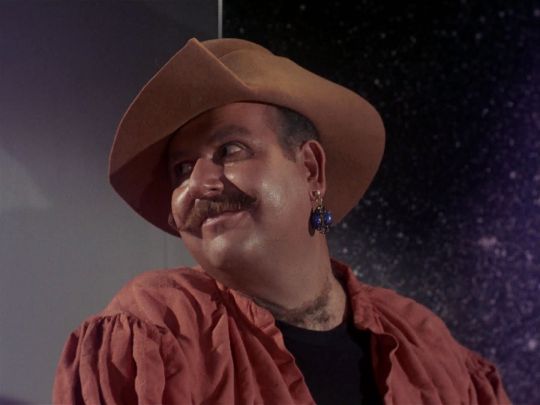
The Verdict
There are so many things to unpack in ‘Mudd’s Women’, and I certainly don’t expect to do a thorough job of it here, nor have I the interest. It’s clear that the intention behind this episode is to highlight something about inner-beauty over physical vanity, but it badly misses the mark while spewing forth one outdated stereotype after the next. Most of the missteps are all pretty obvious, ranging from a depiction of women whose worth are all dependant on finding a husband, to the portrayal of leering men being openly regarded as nothing more than natural and unavoidable (Mudd all but invokes the phrase “boys will be boys”). Additionally, Harry Mudd’s Irish brogue would almost certainly be regarded as offensive and in poor taste if this were made today, which is doubtless why Rainn Wilson opted to forgo that particular characteristic when he portrayed Mudd on ‘Discovery’.
I will concede that most episodes from a series filmed nearly 60 years ago are bound have some problematic elements, but some are more egregious than others, and ‘Mudd’s Women’ belongs in that categorization. Perhaps if the episode had been more clever I might have given it points towards entertainment value and creativity, but even there I found the whole ordeal almost as dull as it was silly. Oh well, you can’t win ‘em all.
½ a star (out of 5)


Additional Observations
This is the first time (according to production order) that we get to see Spock ‘n Bones verbally sparring, which is the only reason I didn’t give this episode a 0 star rating.
Uhuru’s still in gold, and the universe remains as-of-yet out of balance.
The Episode opens with kirk being like “We’re chasing a vessel because it’s suspiciously running away when we chase it”. But like, who wouldn’t? Do Starfleet vessels even have the authority to perform random searches of independent starships? Perhaps they do and I’d just forgotten, but I’d just as easily chalk this one up to a case of “the writers were making it up as they went”.
Harry’s relationship with “his” women feels very human trafficky, which was apparently a concern raised by the studio when the script was put forth as a potential candidate for the pilot. This matter is addressed with several lines of dialogue which establish that each of the women are traveling with Mudd of their own volition, but I’d still characterize their relationship with him as suspicious, at best.

#star trek the original series#star trek production order#mudd's women#retro review#star trek review#Harcourt Fenton Mudd#harry mudd#star trek tos#star trek#captain kirk#james t kirk#spock#bones mccoy#60s tv series#60s tv#60s tv shows#classic television#THAT hasn't aged well#episodic nostalgia
15 notes
·
View notes